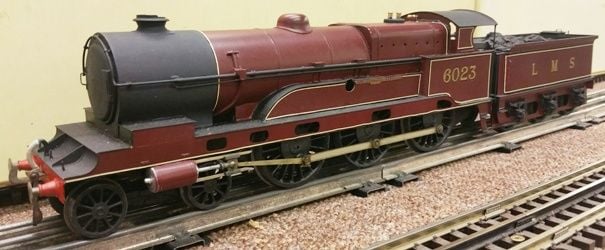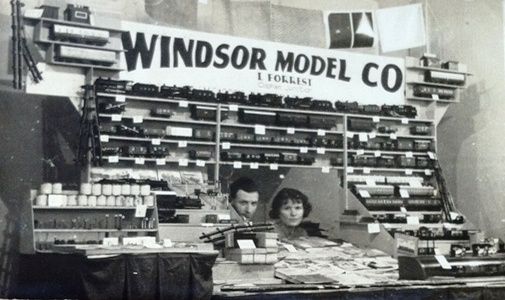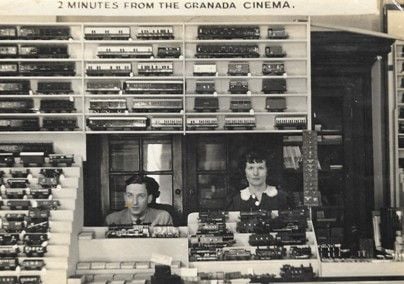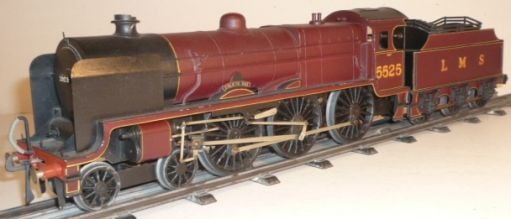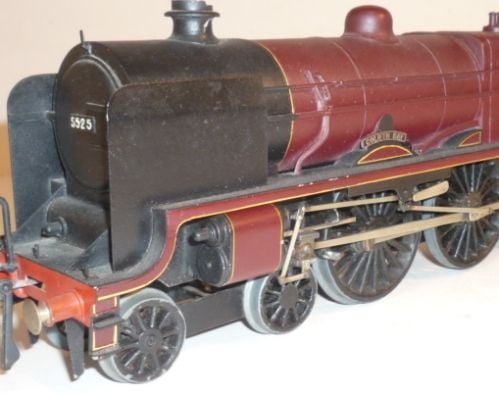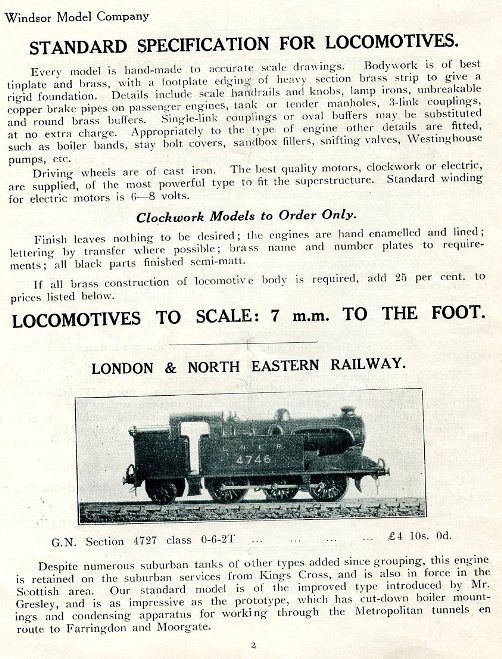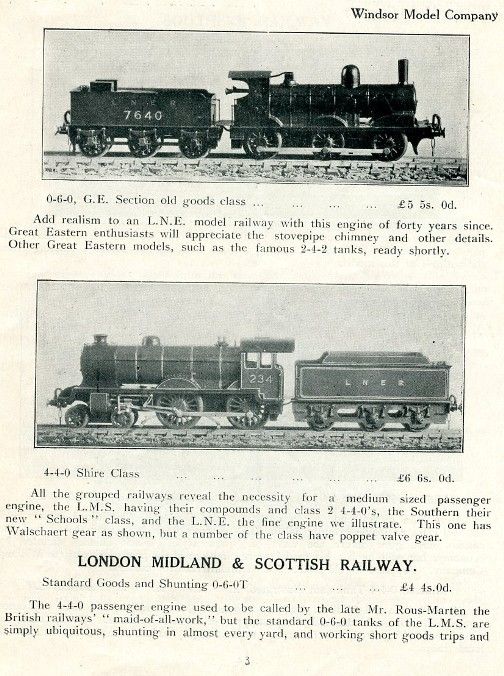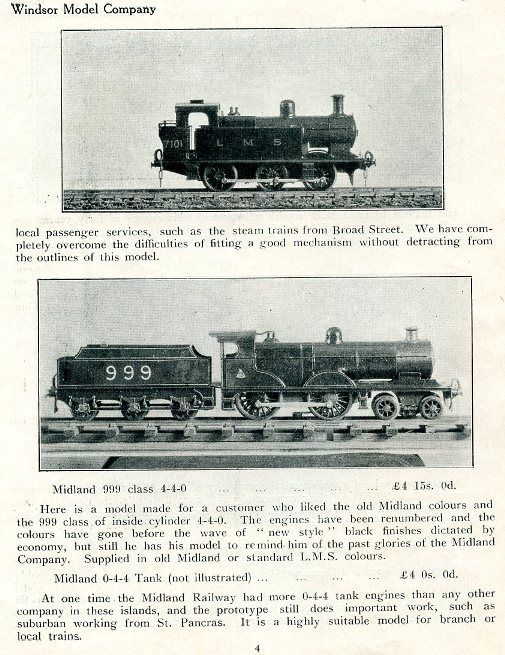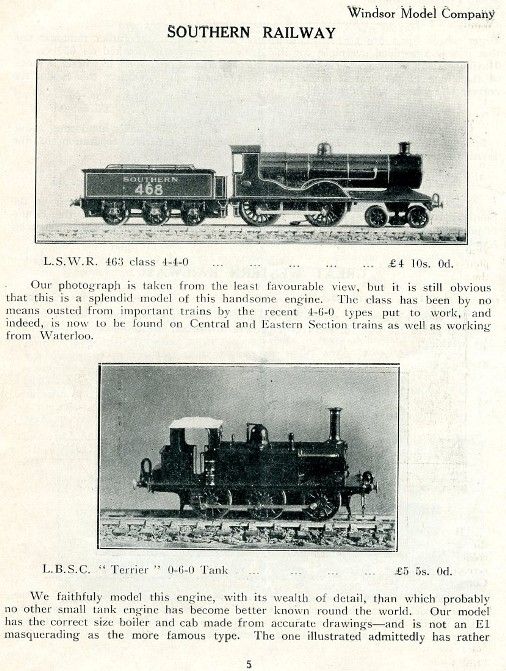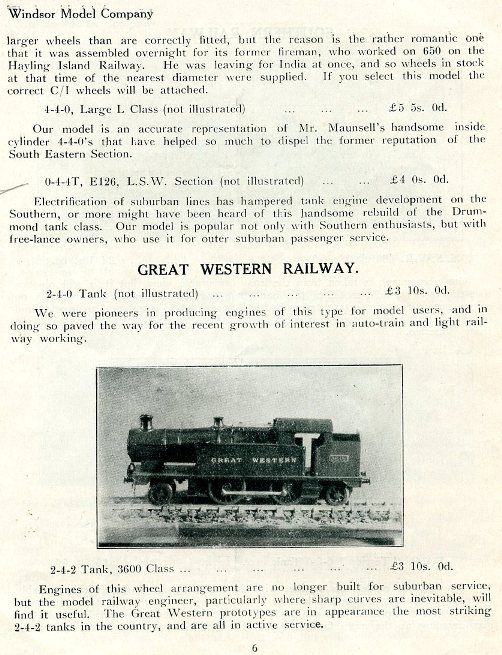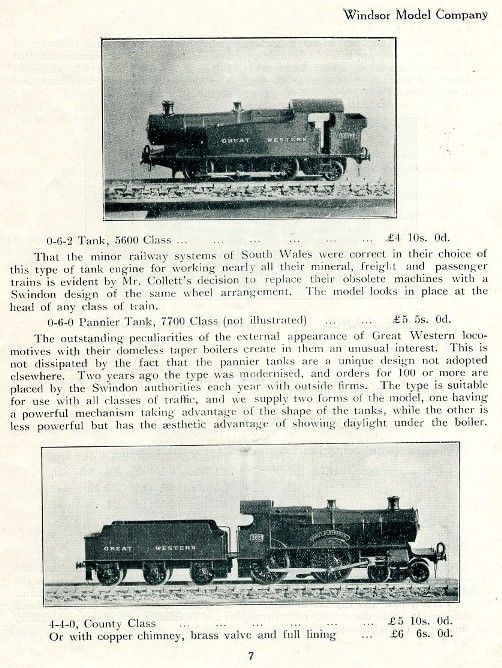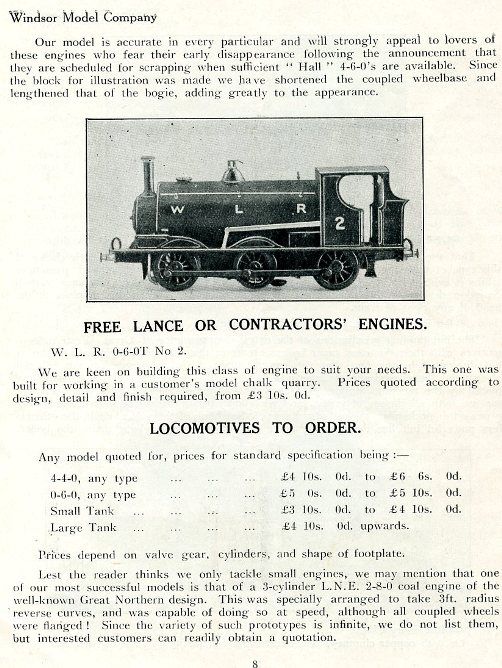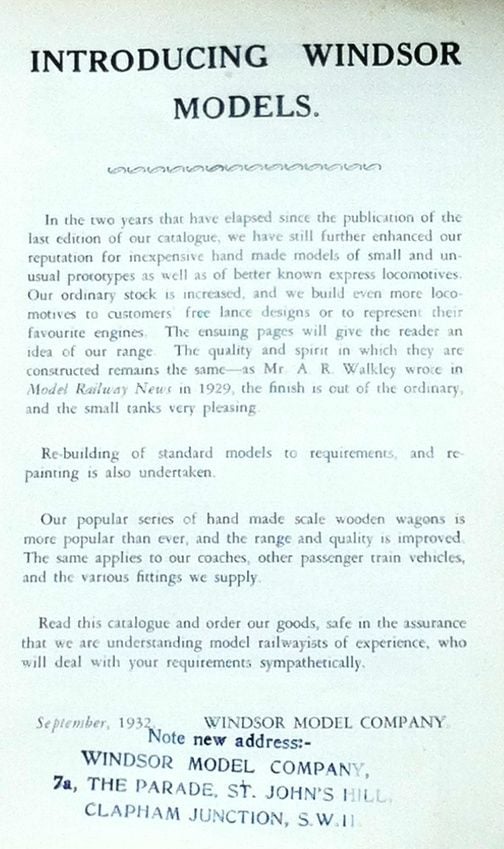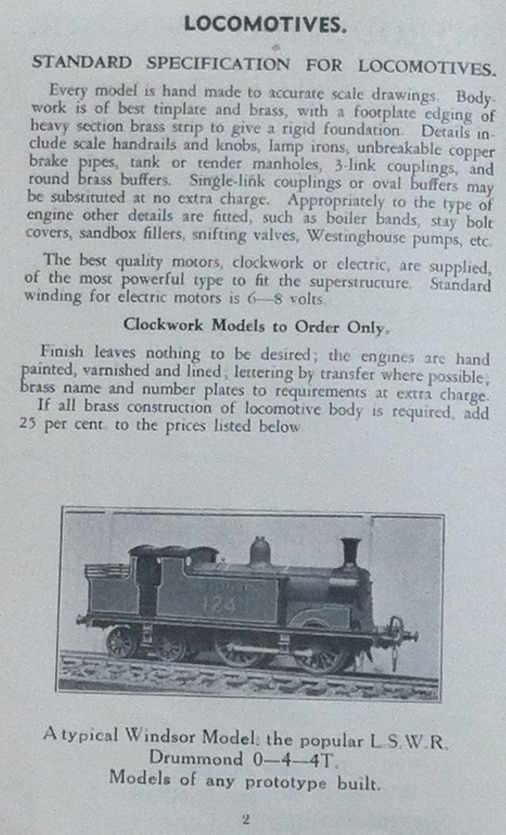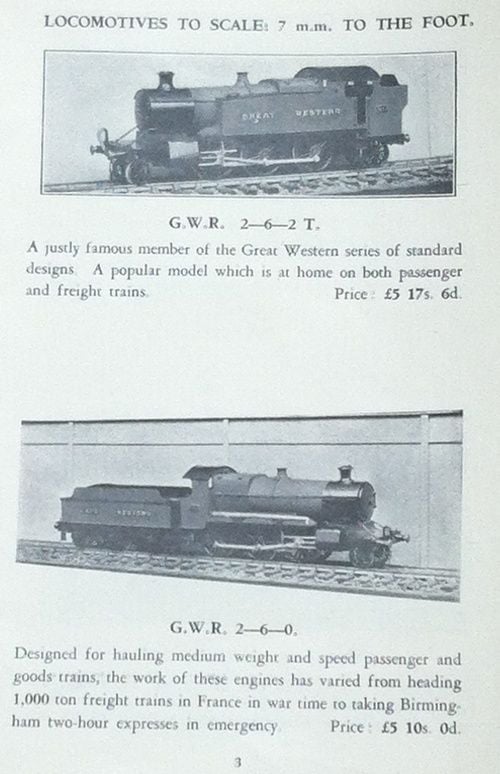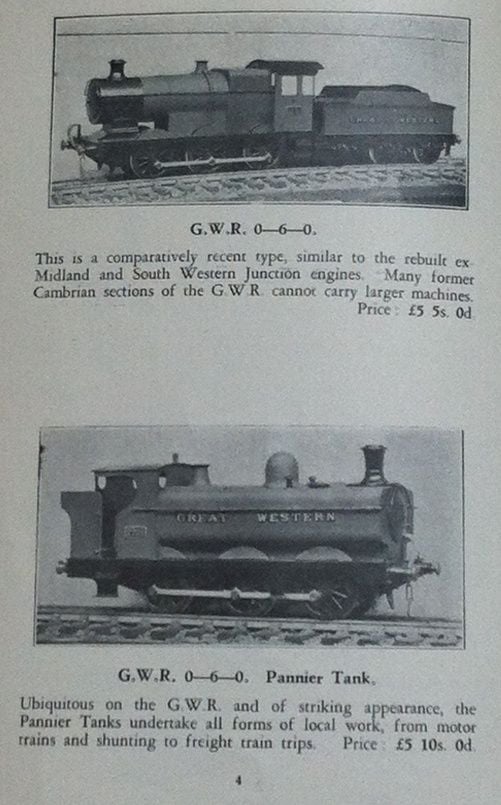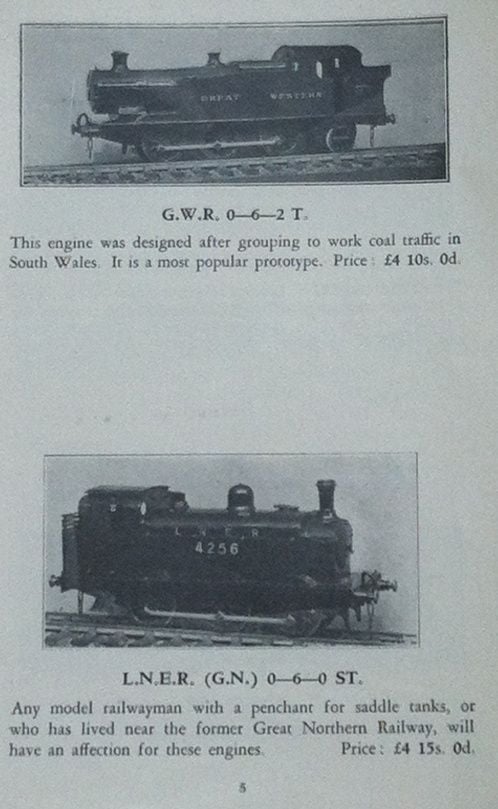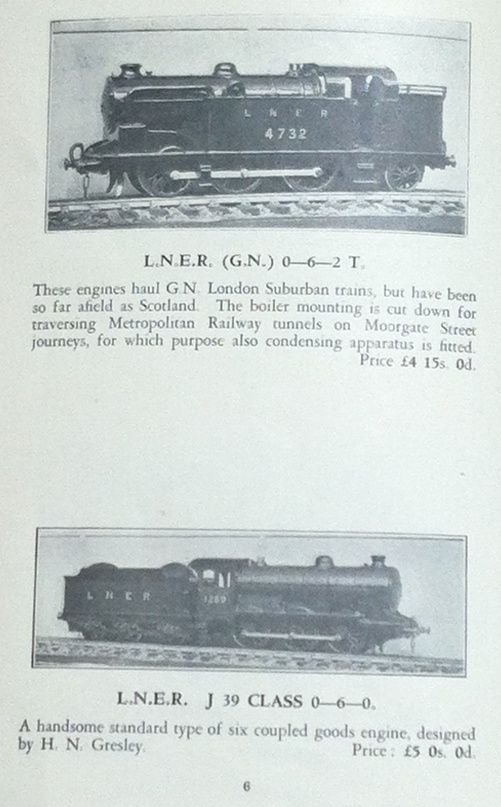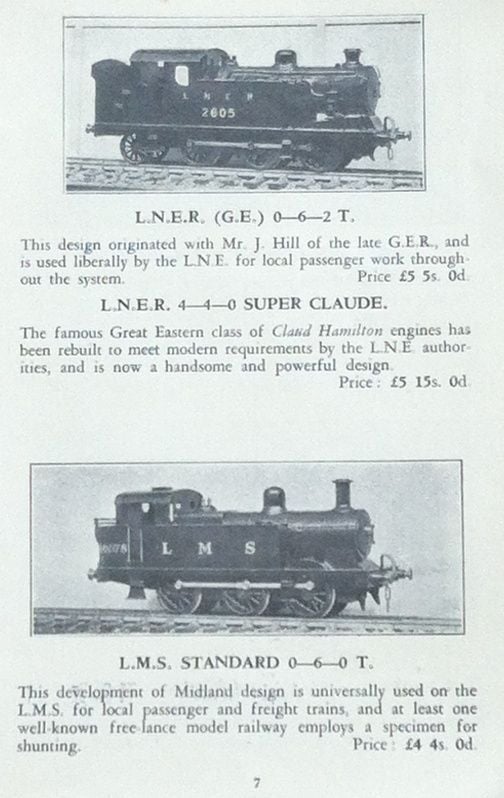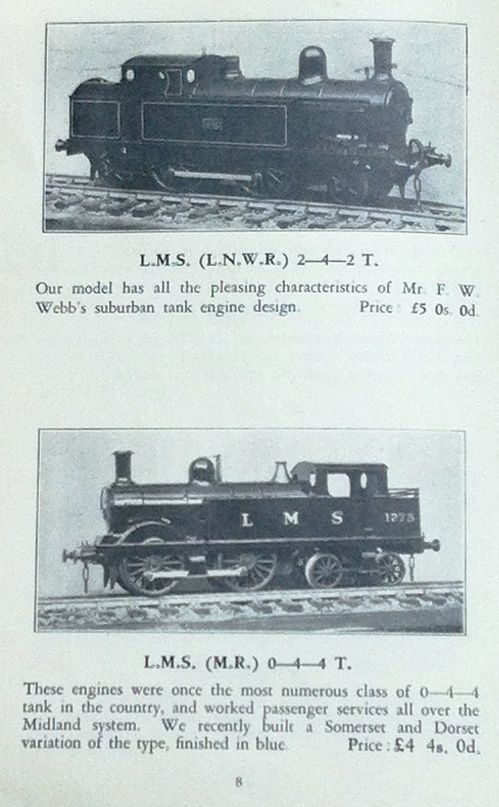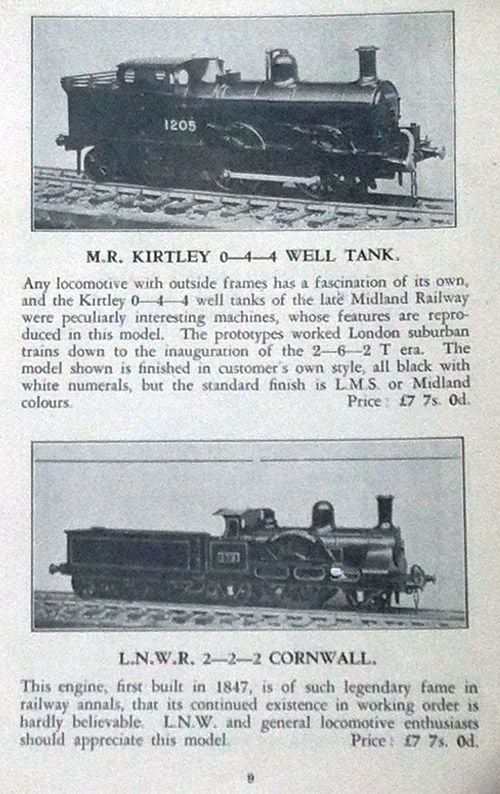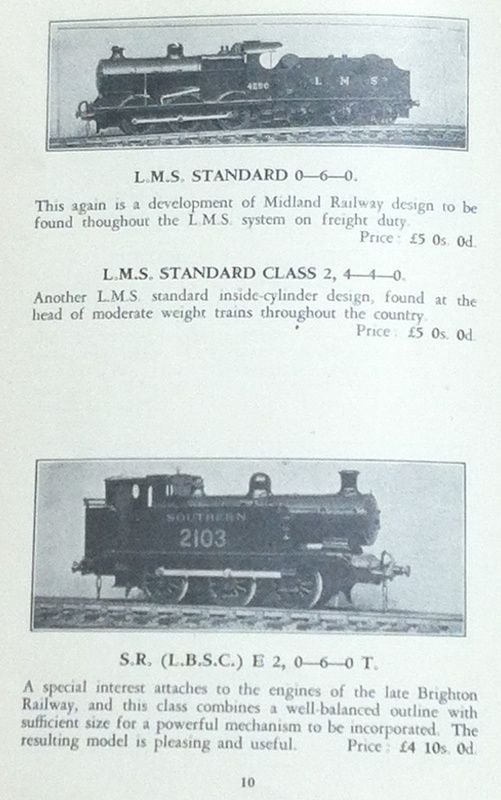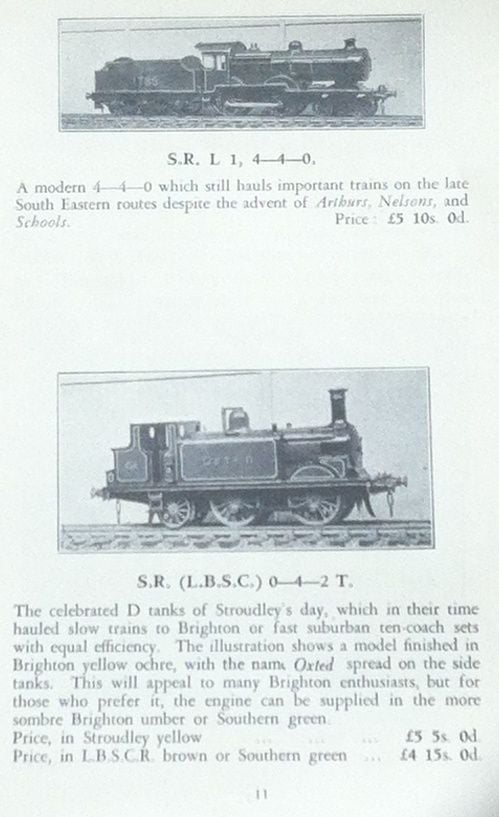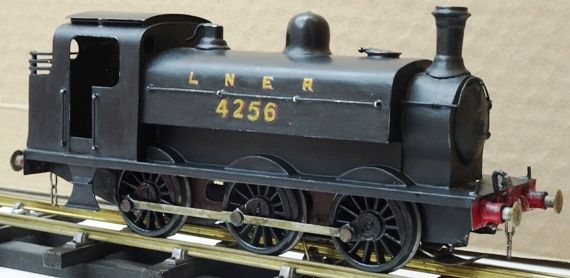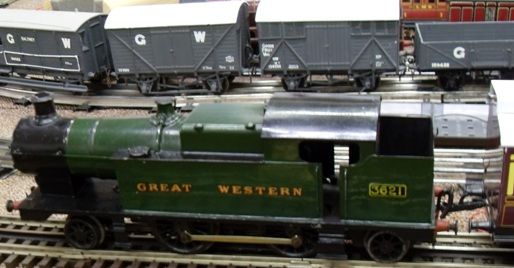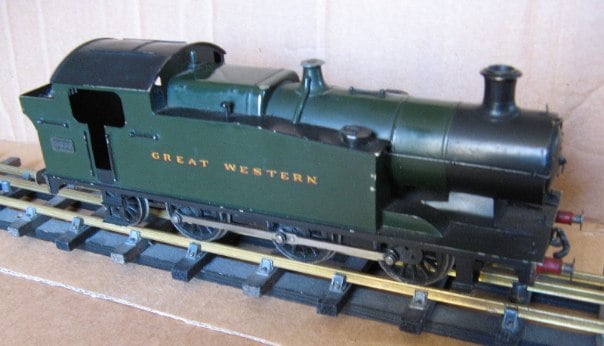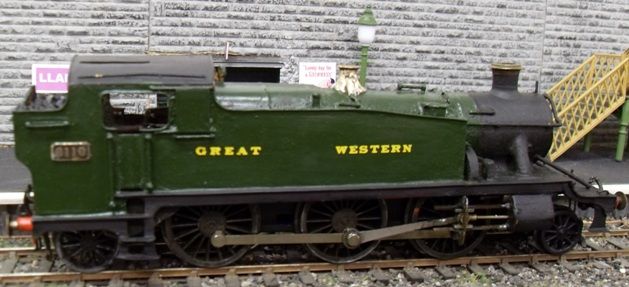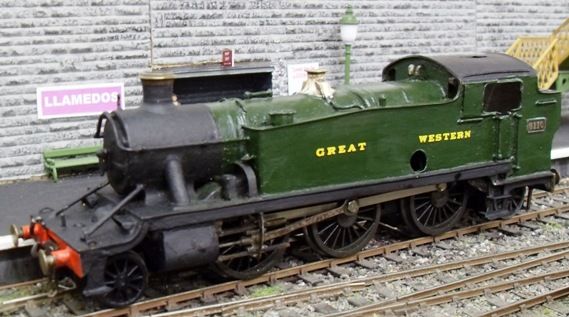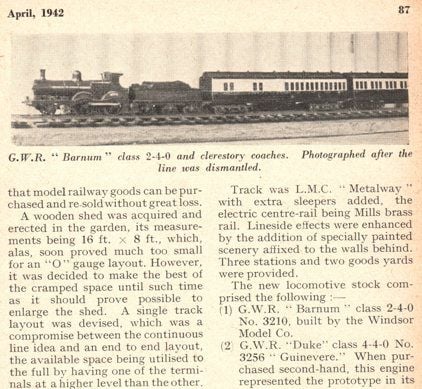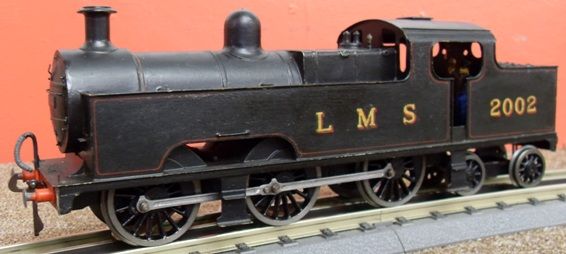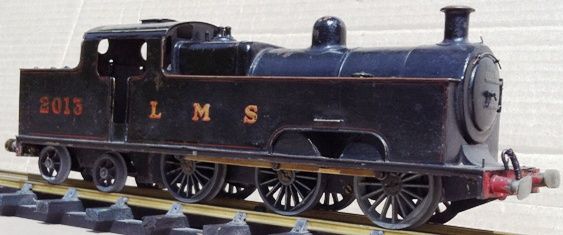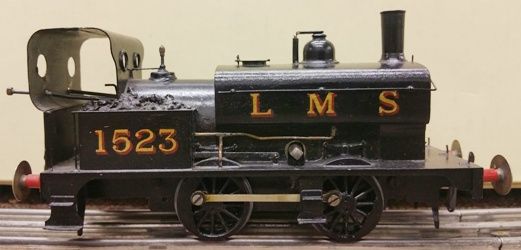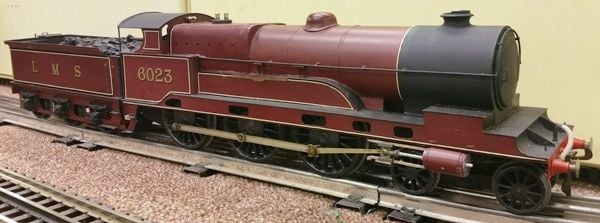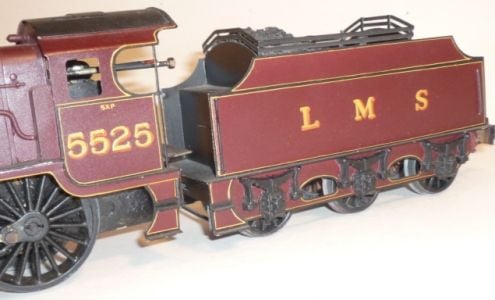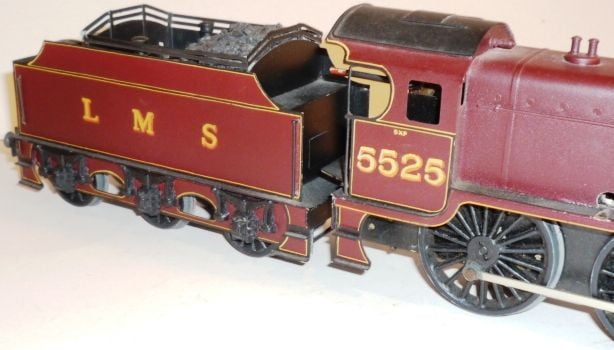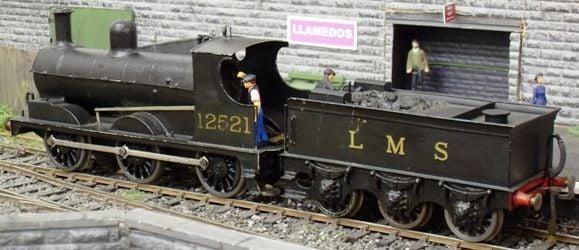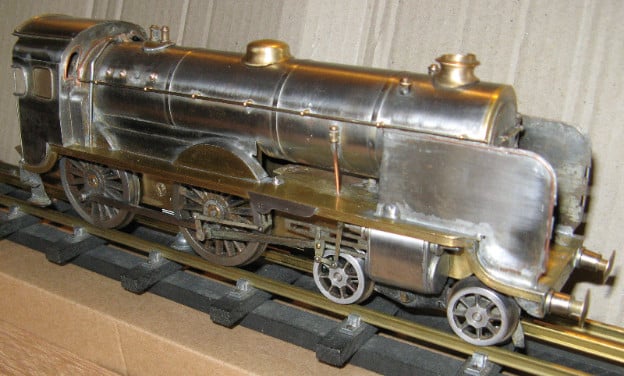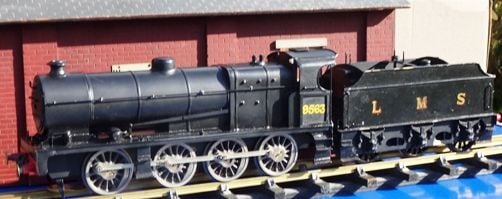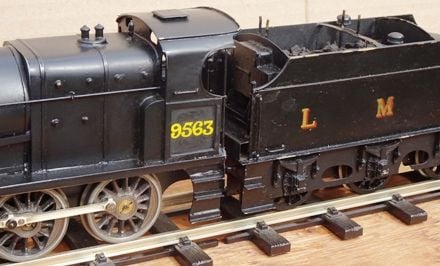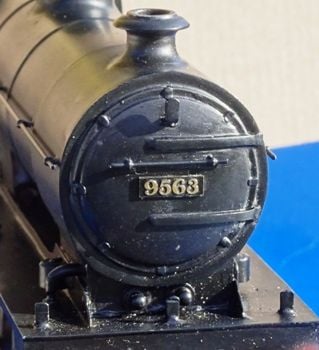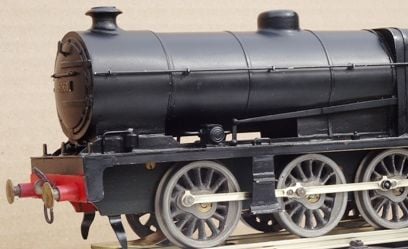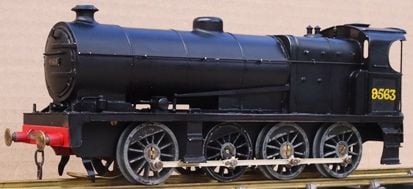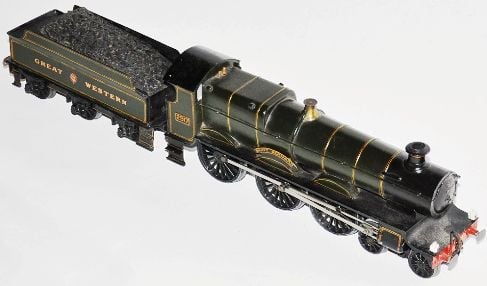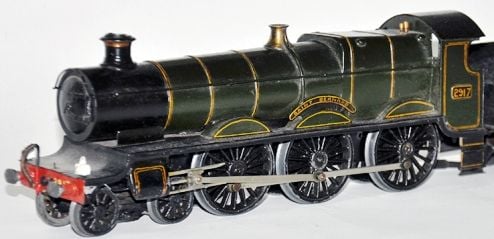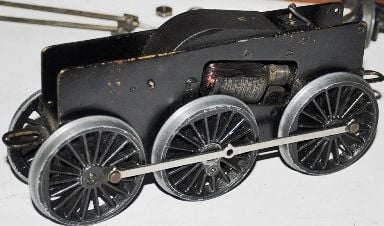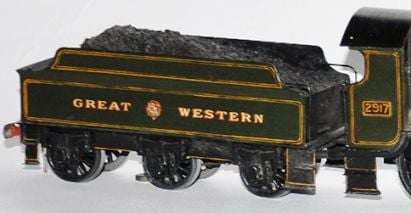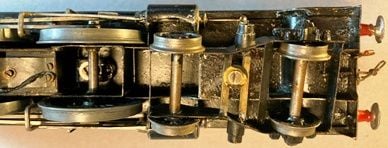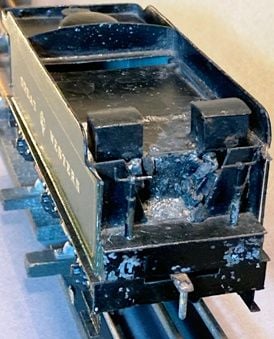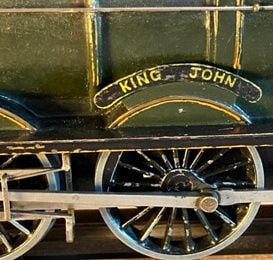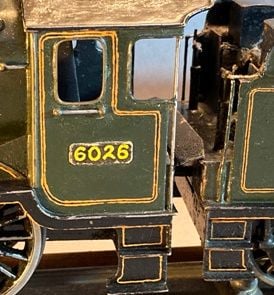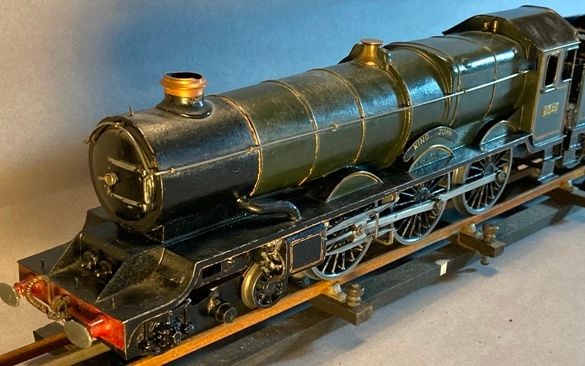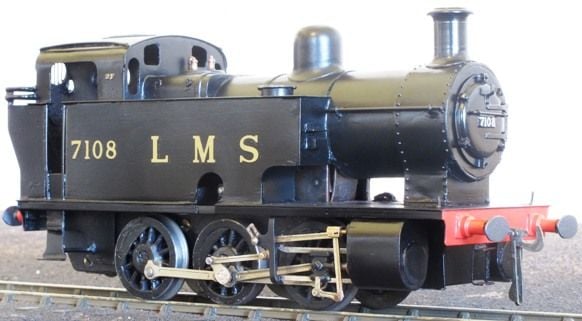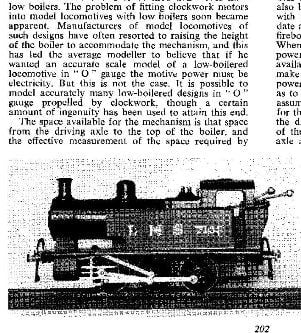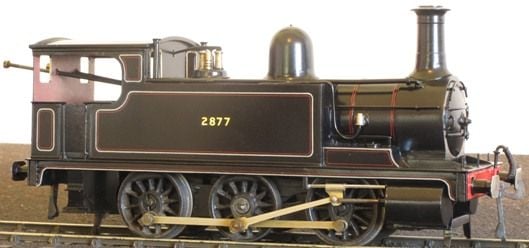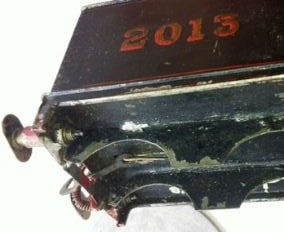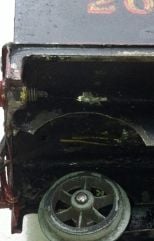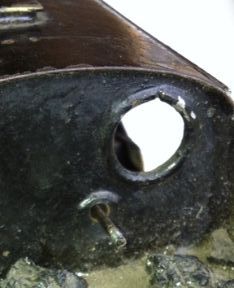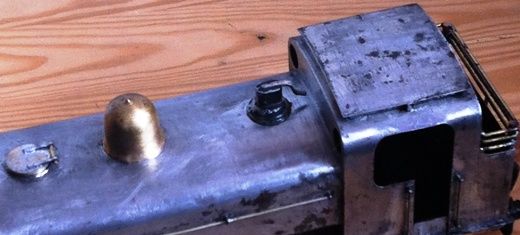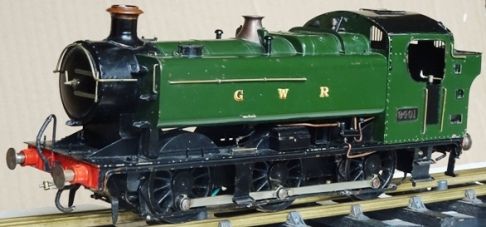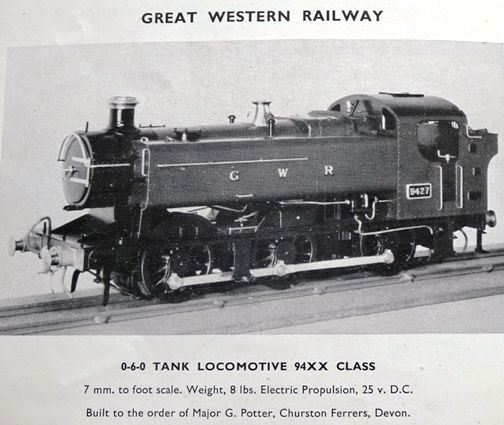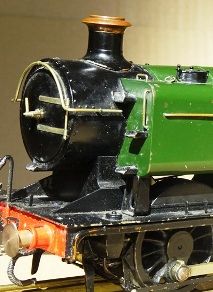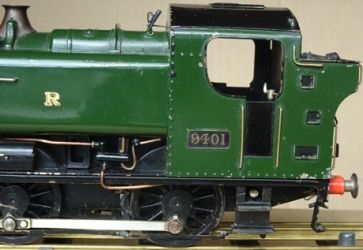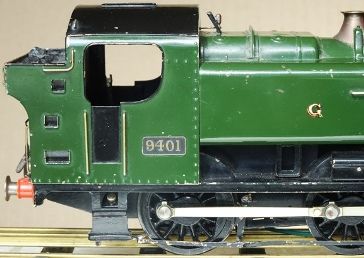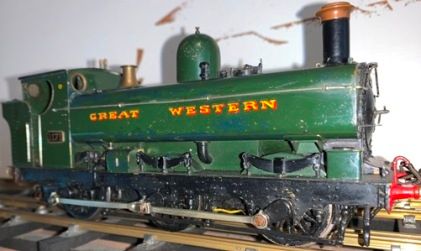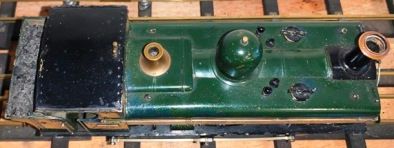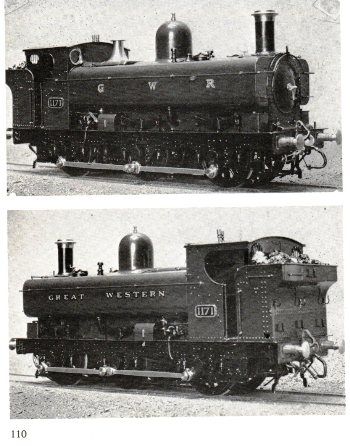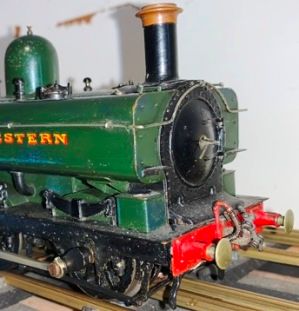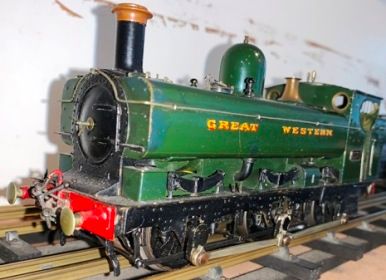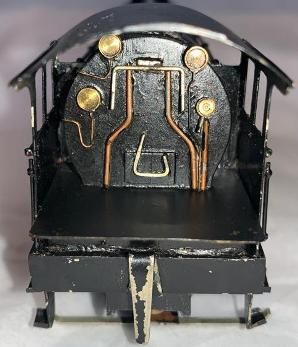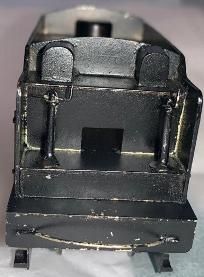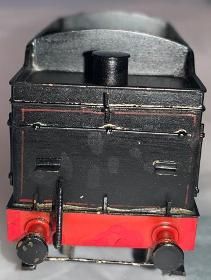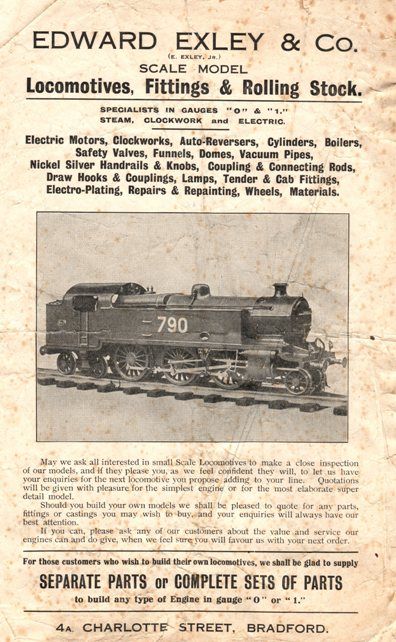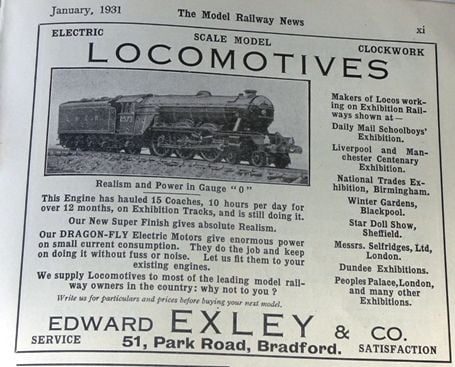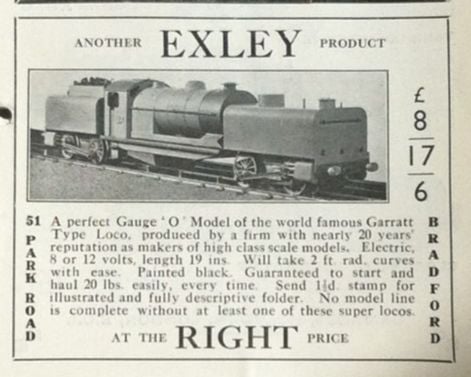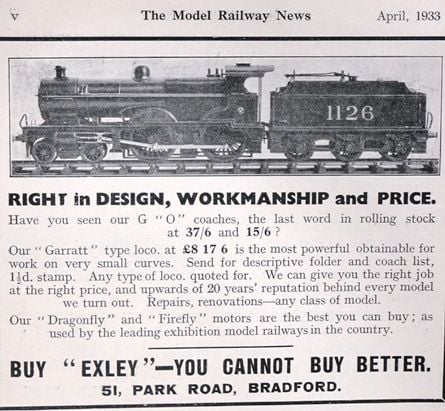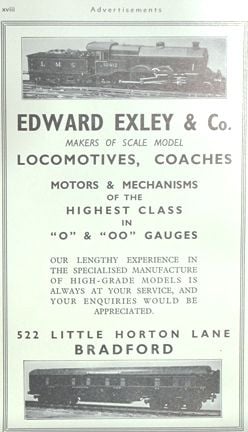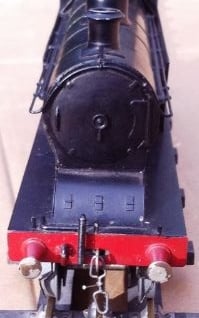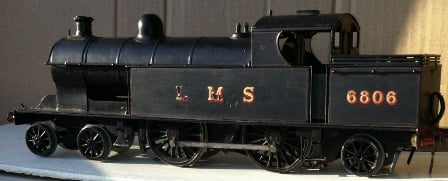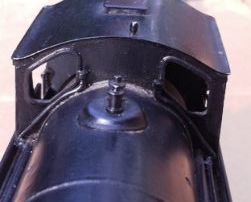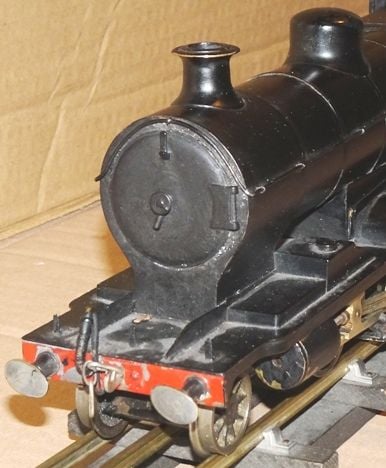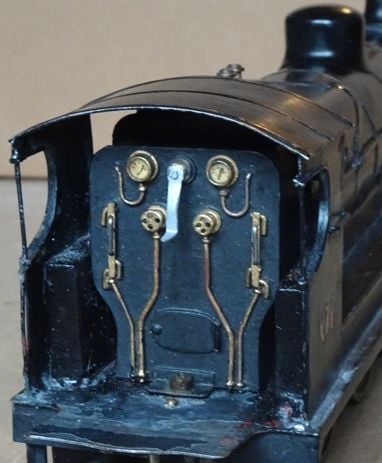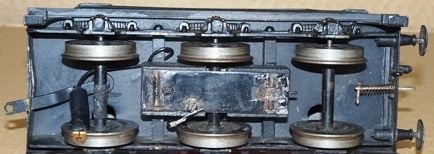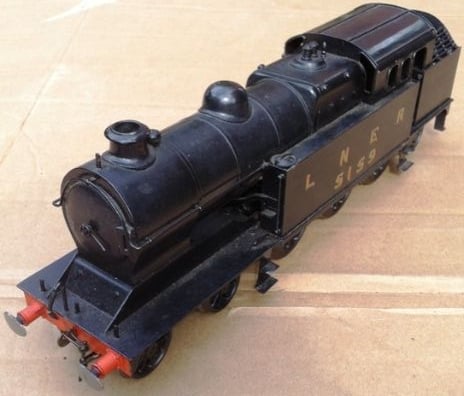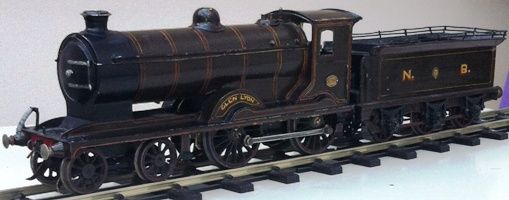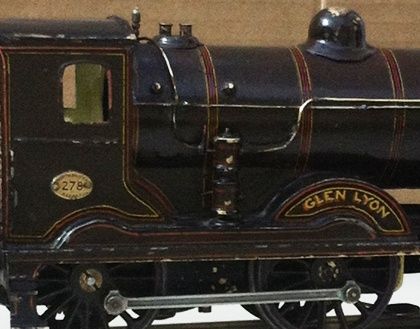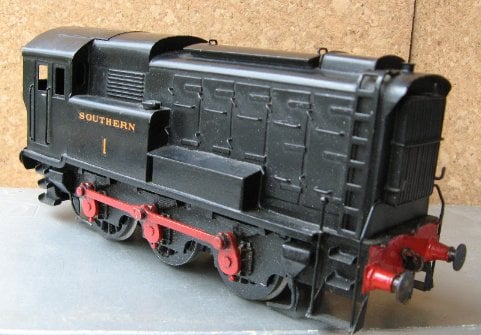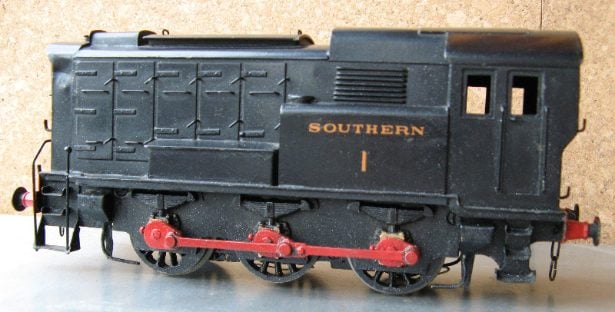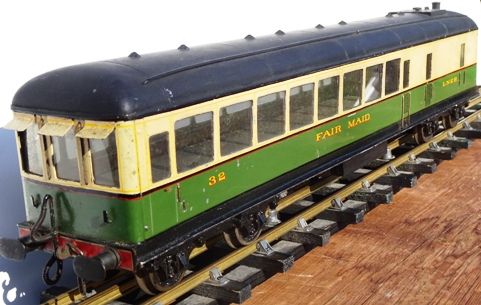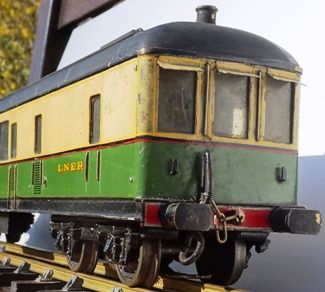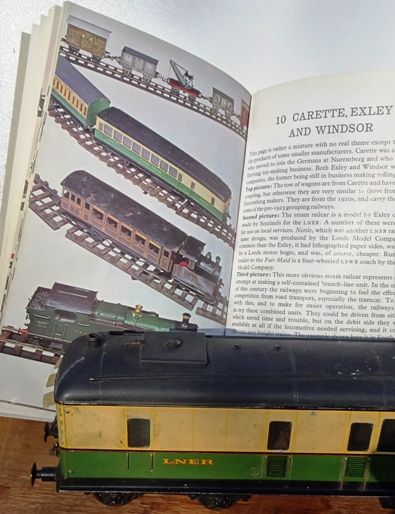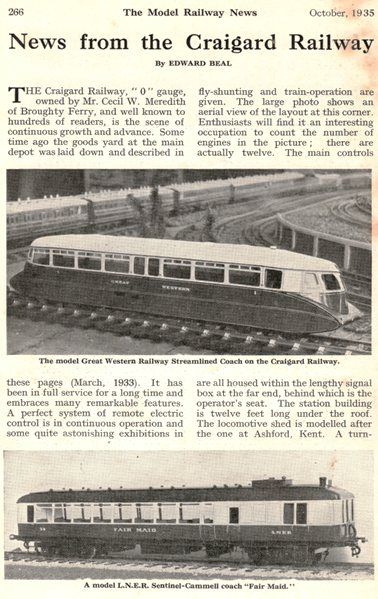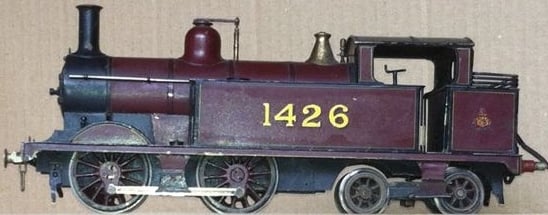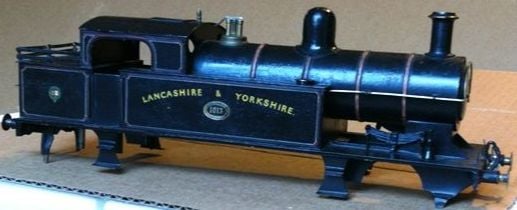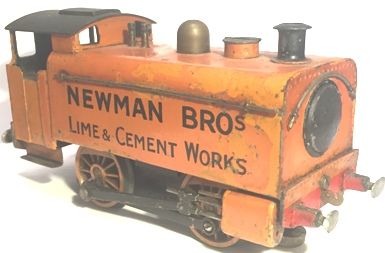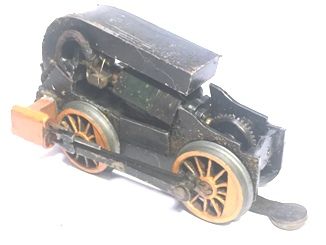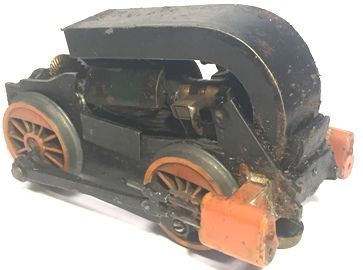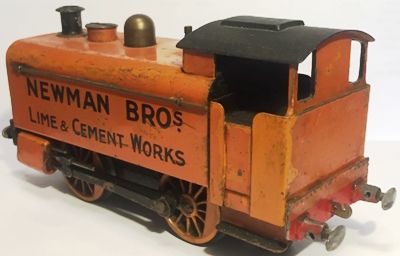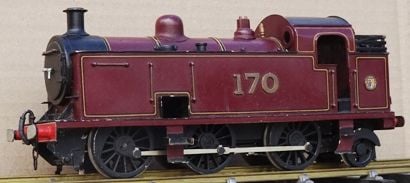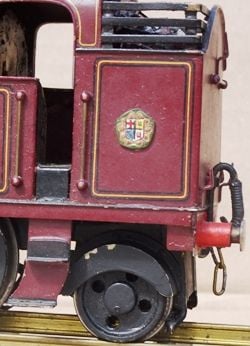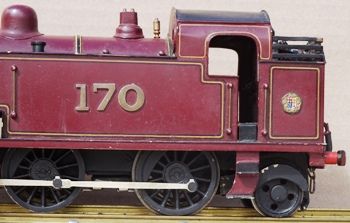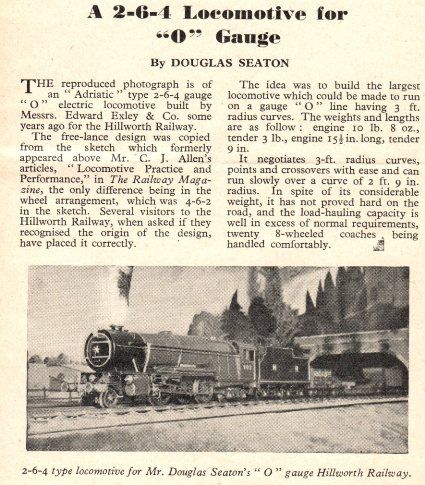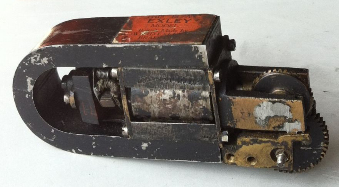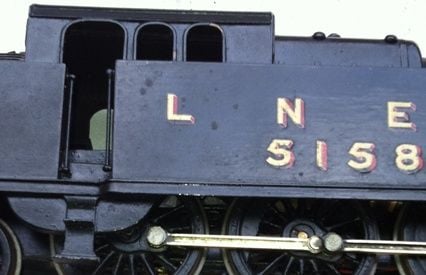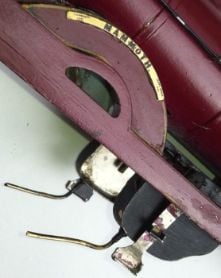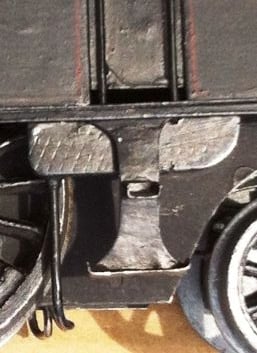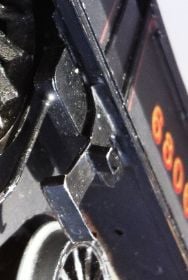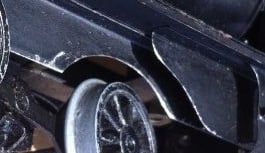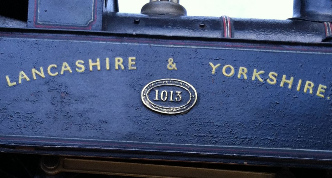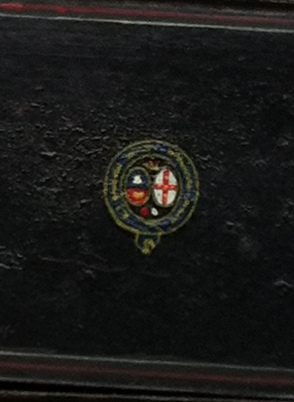
Windsor Models & Exley Locos
***** Material most recently updated in January 2026 *****
Locomotives by Windsor Models and Exley; some illustrations
Copyright is retained by M.L.Harrison for all text and photos, except for those taken by other owners and enthusiasts.
M.L.Harrison 2020, 2025 © All rights reserved.
These two firms were potential contemporary competitors for Milbro in the years before World War Two, and both continued to supply locomotive models after the war (when Mills had ceased offering a range of locos in its catalogues). Exley and Mills sometimes collaborated (and there are post-war examples touched upon in our Milbro material), but I have not so far seen anything to suggest a collaboration between Mills and Windsor Models.
WINDSOR MODELS This firm appears very undervalued in the literature of UK model railways history, but the company produced good locos which related well to contemporary prototypes. Furthermore, this was one of the pre-war model-building enterprises that survived into the post-war years, when some very good models were made. Windsor Models Company locomotives sometimes turn up on Ebay or from dealers, but I do not necessarily always find it easy to identify them with certainty. Their earlier models generally seem to be of tinplate, while later on they were made in nickel silver. One standard feature was the use of a brass footplate edging section running along the locos below the footplate on each side (although other companies also used this feature from time to time, and I think nickel silver might be substituted for brass by Windsor in some later cases). This practice of an edging section was mentioned in Windsor catalogues, and the firm also offered to build bodies in brass if requested. As far as I can tell, the tank locos would often have had simply-designed fixed frames sections below the bodies at front and rear (as with LMC), although when an owner changed the mechanism the replacement unit was sometimes sited within new full-length brass frames (and the original fixed tinplate or nickel sections might be removed). The use of nickel silver by vintage model makers might sometimes mean a lighter style of building, and this may have applied to some late Windsor locos. Someone wanting to collect relatively inexpensive vintage models of good quality could well choose this company, although time and determined searching might be needed to assemble a solid group of examples. Recently, however, prices have risen as Windsor engines have become more appreciated. In the past, like some standard tank engines of the LMC range, Windsor locos might be improved, enhanced, adapted or repainted by enthusiasts, offering a way of achieving even more realistic representations of diverse prototypes at very reasonable prices. Many Windsor engines must have given long and useful service on layouts. In addition, the company could build excellent special order items, and some of these appear amongst the examples below. In the post-war years the proprietor of Windsor Models (Leslie Forrest) created several engines for the well-known Sherwood layout, an 0 gauge railway that featured frequently in the model railway press. Reference is made again to this layout below. It had a long history, and was covered in articles in the 1930s as well as through the post-war years. For Leslie Forrest there was a continuity of client here, as Windsor Models had supplied locos for this layout in the 1930s too (see Lewis, J., 'Lovely - but what's the provenance ?', Newsletter of the Bassett-Lowke Society, May 2024, 34, 2, pages 24-26). It seems that a variety of clockwork and electric mechanisms were used over the years of production (including Bassett-Lowke clockwork mechanisms and Leeds Model Company electric ones). The firm sometimes put four-wheel clockwork mechanisms into locos with six driving wheels. This might partly have been to make a cost saving, but it could also enable a more accurate model where the builder wanted to create daylight under the boiler. We comment further on this below. In early 2025 an enthusiast very helpfully passed me images of some excellent Windsor Models documents focussed around a specific commission (for a GWR Castle). These are rare items and give quite a lot of insight about the firm and its products. They are shown below along with the loco to which they particularly relate.
Acknowledgements and sources * I am very grateful for help I have been given with advice and material for this section, and for catalogue pages and photos of engines. * For useful information on Windsor Models, see the section at the binnsroad website * For helpful coverage in print, see 'Smaller Manufacturers (2) Windsor Models' and 'Smaller Manufacturers Update 2' by Bob Burgess in the Newsletter of the Bassett-Lowke Society; 24, 1, February 2014, pp. 14-15, and 24, 2, May 2014, p. 22. * Regarding the Sherwood layout and its engines, there seem to have been lots of mentions in earlier periods within journals, etc. A good start for anyone wanting to read about this would probably be the three interesting articles that appeared in the Model Railway News in August, September and November 1957, with the third of these including a list of its 31 handbuilt locos. See Eagles, N., 'The Sherwood Section of the LMSR: 36 years of railway modelling', 33, 392, pages 188-192; 33, 393, pages 234 & 237; 33, 395, pages 268-269 & 273.
A few introductory pictures
Illustration WM1 An excellent special order LMS (ex-LNWR) Claughton, 'Sir Charles Cust', made by Leslie Forrest, the proprietor of Windsor Models. I have been informed that this loco dates from 1956, is made of nickel silver, and is fitted with a Bassett-Lowke 6-wheel clockwork mechanism. It would be nice to stand this engine alongside the Claughton shown in my section on Bernard Miller. The latter model was made perhaps more than twenty years earlier in tinplate. These two rebuilt Claughtons are from what was an unbroken tradition of creating fine handbuilt models to meet the expectations of the three-rail era. I am grateful to the owner of this loco and of some of the others shown below for having provided valuable illustrations and information. Number 6023 was supplied by Forrest for the layout of Norman Eagles. This model railway was widely known amongst 0 gauge enthusiasts, and was referred to as 'The Sherwood Section of the LMS' . The layout and its engines featured in a large number of articles and comments in model railway journals and books over a long period (and even into the 1970s: see for instance pages 33 and 37 in Hornsey, P. (ed.), 'An Introduction to Model Railways', New English Library, London, 1977).
Illustration WM2a. I have tried to reproduce here a photograph that turned up on Ebay. The original has a browner look to it, but carries no date. Written on the back in capitals is the pencil comment; 'Leslie and Pat at the London Exhibition'. There is a very impressive array of model locos on the top shelf, and it is a pity we cannot see them better !
Illustration WM2b. Many thanks to the enthusiast who sent me this photograph, which reinforces the impression of a firm offering considerable variety and realistic models. The date is not known here either.
Illustrations WM3a and WM3b I am grateful to Mike Delaney for providing these two pictures (and two more shown below) of an excellent Windsor LMS Patriot loco which Mike sold some time ago through his well-known vintage trains website. LMS number 5525, 'Colwyn Bay', was made to a high standard in clockwork by Leslie Forrest during the post-war period of production (like the Claughton shown above). I understand the model was directly linked with Leslie Forrest through family connections, but it is also one of those included by Norman Eagles when he listed the engines running on the well-known Sherwood layout in 1957 (see Acknowledgements and sources above).
Illustrations WM4a-WM4c. We show now another handsome and interesting 0 gauge loco that also was part of the Sherwood enterprise, but was not produced by Windsor Models. Powered in the past by clockwork, this 700 Class model is currently a 3-rail electric model. Its provenance and origin have been explored and explained in discussion within two issues of the Newsletter of the Bassett-Lowke Society (see references below). Drawing on these writings, we can say that the engine was initially suspected of being made by Leslie Forrest, but seems very likely instead to have been built by Charles Sewell of Salisbury after Forrest's retirement in 1958 . This new supplier seems to have provided fifteen locos for the layout. Number 719 was apparently reported in the model railway press, and appears to be an outstandingly good model. Perhaps it is reasonable to think of this loco as representing the destination towards which Windsor Models might have needed to go for their top commissions, had they continued through the 1960s. Many thanks to its owner for letting me show these photographs. The two very interesting Lowko News commentaries are cited below. See Jonathan Lewis, 'Lovely - but what's the provenance?', Newsletter of the Bassett-Lowke Society, May 2024, 34, 2, pages 24-26; and John Davies, 'Response', August 2024, 34, 3, pages 6-7. Catalogued locomotives from the pre-war period The variety and realism of the engines on offer in the 1930s can be seen from the catalogue pictures below, and from comments in the firm's texts. The prices may be compared with those in Milbro catalogues (where figures are much higher for comparable engines within the Mills scale model range). It has been said that the Windsor Model Company "had the laudable policy of building the best model possible at a reasonable price" (Gomm, P.G., 'Older Locomotives, 1900-42', Troy Model Club Series, Nelson, London, 1970, p.37). Thus, despite the relatively modest prices being asked for what were semi-scale models, the catalogue illustrations showed engines that were quite convincing even when representation was having to be significantly simplified. My guess, however, is that quality in any case may have varied a little over time as well as to match demand and specific commissions, and perhaps particular engines might vary from the catalogue pictures on specific details. Going over fully to nickel silver for locomotive bodies at the end of the 1930s might itself be seen as an indicator of rising standards and expectations. In addition, although a few of the earlier tinplate locos may seem relatively plain, there were probably some higher quality special order models even in that period.
Illustrations WM7a-WM7G Pages from a catalogue produced in or around 1930. Many thanks to the enthusiast who sent me these. They outline the company's approach and show examples of the locos on offer. The last comment in the text above is particularly worth noting, with its mention of a 2-8-0 freight loco. I have seen another large freight loco attributed to Windsor Models, a Beyer-Garratt model. This seemed to have started out with two clockwork mechanisms, although these had been replaced with modern electric ones. It was an attractive but quite simple version of the LMS prototype. NB I wrote the above comment some time back, and later unearthed a picture of the Garratt which is shown further down this page.
Illustrations WM8a-WM8k. Pages from a catalogue produced in 1932, showing an impressive array of distinctive locos. The pictures include thirteen tank engines and six small- or medium-sized tender locos.
Images of some of the locos catalogued before World War Two
Illustration WM9a. Examples of most of the Windsor catalogued locos seem surprisingly uncommon, so perhaps the batches made were not very large. I was certainly pleased to find this tinplate saddle tank some years ago, although it needed a lot of work. It had been damaged, lost its original transfers, and been repainted bright green. I tried to restore it as best I could to what it might have looked like after ninety years of fairly careful use, if it had not been altered ! Its mechanism had been replaced by a modern one that was itself damaged and non-functional, but the present owner is planning to fit one of the excellent smaller Read-Maxwell motors.
Illustrations WM9e and WM9f. Two GWR tank engines from the Windsor range. Thanks are due to the owner of the 2-4-2 tank for letting me have the first of these photographs. The 2-4-2 has a 12 volt DC mechanism. The 0-6-2 tank is made of nickel silver, a material the firm went over to at the end of the 1930s. It has been converted from clockwork, probably in the 1940s or 1950s, and now has full-length brass frames inside. Despite simplification, it is in my view a very convincing model for its period. Apparently this particular engine belonged - rather appropriately - to a South Wales model railway club.
Illustrations WM10a and WM10b. Two pictures of another GWR tank loco, a 'prairie' catalogued in the 1930s by Windsor Models, albeit in an earlier form. Many thanks to the loco's owner for these photographs, which were taken at model railway shows. The engine started out as a clockwork one (and the keyhole has been retained), but given the damage to its original mechanism it was converted to electric running. It has also been repainted.
Illustration WM11a. I am not certain that this 4-4-0 was made by Windsor Models, but in the absence of further information (and given its construction style) that firm seems at the moment the most likely maker. It has been a clockwork engine at one point (although not necessarily when first made), but came to me with no mechanism at all. Although a BR loco, it has LNER on its tender, and perhaps was made at the end of the 1940s or in the 1950s. It seems to be constructed primarily of nickel silver, looks to have been professionally made, has modest but effective detailing, and was built to be quite robust. There was no nameplate on either side. A loco of this class was catalogued much earlier by the firm (although with a different tender and detailing), and perhaps this type of engine may have remained in the Windsor repertoire right through into the post-war years. The 4-wheel Bond's mechanism shown in our coverage of Bond's elsewhere on this site seems potentially to be a good fit for this engine (see Illustration V37), and it might even have had such a motor when first built.
Illustrations WM11bi and WM11bii. A nickel silver model of a J39 that I think was made by Windsor Models in the late 1930s or soon after the war. It seems to have been professionally repainted, and now carries a running number that the full-sized loco was given in 1946 (for details about that J39 see Yeadon's Register of LNER locomotives, 1996, Volume 11, pages 23-24). The transfers are very attractive, and might have been from Exley (or even Mills). The loco has lost its front steps, and the soft metal base on its safely valve unit has had to be replaced by one in good condition, but the body is otherwise little changed from when it was made. The build feels just a little lighter in some ways than for a 1930s tinplate engine, and the strip edging the footplate (in Windsor style) is relatively modest. The engine has been fitted with a Bond's motor contained in a Bond's chassis, and this whole unit would have been supplied as a complete item by that firm (for this loco or for another one). The flat sections of metal running along each side of the loco body behind the middle and rear splashers are as long as they are so as to conceal the very large mechanism. It is hard to date examples of this type of Bond's mechanism with any precision, but it could have been requested by a purchaser when the loco was commissioned, or put in later when the engine was repainted. I think this model is an excellent example of a catalogued tender loco type, although from a slightly later period than that catalogue. It is interesting to see how very plain it is in terms of detailing, even though made of nickel silver. It would be easy to enhance it, and I guess that must have happened quite often over the years with such items. In any case, individual Windsor locos of the same classes may differ a little over time, and it is possible another Windsor J39 might turn up with additional detail added by the maker, or with some minor variations in basic features from this one. The Mills J39 as catalogued looks very similar, but has much more detail. Interested readers might like to compare this very plain model with the LMS 700 Class loco shown earlier. Despite the difference in detailing and period of construction, they are both from the same broad vintage locos tradition, and the 4-4-0 was initially made for clockwork.
Uncatalogued models and special orders From reports scattered through the pre-war and 1940s model railway press, it looks likely that quite a few enthusiasts chose to use Windsor engines on their layouts, and this might sometimes mean commissioning specific models of their own choice. An interesting example can be seen in the magazine extract shown below, from 1942.
Illustration WM12. The Model Railway News of April 1942 carried a report by an enthusiast J.B. Barnes about his layout. He had the Windsor GWR 2-4-0 tender engine shown above amongst its loco stock, as well as a GWR 2-4-0 tank by the same firm. There was also a 'Duke' Class model that had been rebuilt by Windsor. The 'Barnum' is shown above hauling clerestory roof coaches specially built by the same company. (See 'The Ashdown, Baydon & Aldbourne Railway', 18, 208, pages 86-89.)
In spring 2025 an enthusiast sent me some images of documentary materials from Windsor Models that illustrate the initiation and progressing of a specific 'special order'. At the time when he had taken the pictures he had been the owner of the commissioned model, a GWR Castle, and had also taken photos to show the model itself. We include one of these below, followed by the documents.
(Interestingly, the buyer was interested also in a 2-8-0. Both engines were to be made of nickel silver.) (Note that fluted connecting rods were specified.)
Illustrations WM13a-WM13d. A Castle class loco built by Windsor Models in the late 1930s of nickel silver, together with documentation referring to the commissioning and progress of the model.
I have only had access to material from two Windsor catalogues, and there may have been further advertising material I have not seen, showing additional engines. From the material to hand so far, however, it looks as if the items below were not catalogued (as was the case with the Castle above). If any reader knows that to be incorrect, please get in touch. Advice from an enthusiast with much more knowledge than me indicates in any event that some special order models such as those shown below would most likely have been available more generally to meet ongoing requests, rather than necessarily all being made as 'one-off' products. This certainly seems to be indicated in the case of the special order 'flatiron' pictured below. LMS 0-6-4 tank number 2002 is an attractive model made for a specific model railway, the famous Sherwood layout mentioned already above. The second flatiron, pictured after it, is clearly also of Windsor origins, although older and simpler. It has had its clockwork mechanism changed (and a new keyhole has been made), and the metal has been 'cut about' inside the loco body. Nonetheless, the engine retains its original character. It is a tinplate model, and was most likely made before the late 1930s, while the more developed 2002 was made in 1953. The latter loco can be seen at a distance in a general view of a loco depot on the Sherwood layout in Hornsey's book, cited above (see page 33).
Illustrations WM14a and WM14b Two LMS (ex-Midland) 'flatiron' tank locos. The 1953 model (numbered 2002, and built for the Sherwood layout) has been given a later DC electric mechanism, having originally had a Bassett-Lowke clockwork one. Many thanks to the model's owner for supplying this photo. The older Windsor flatiron in the second picture has had its original clockwork mechanism removed and an alternative (also 4-wheeled) one fitted at some point in the past. It needs renovation inside, but has retained quite well its external paintwork and lettering. The older model is in tinplate, and has less detail than the post-war one.
Illustration WM15 An ex-Midland LMS 0-4-0 saddle tank, also made for the Sherwood layout. Thanks to the owner of this model for letting me have the photo (and the one below). I am informed that the mechanism in this tank loco is a very small Marklin one.
Illustration WM16 The LMS Claughton shown above in Illustration WM1, this time seen from the other side.
Illustrations WM17a and WM17b Two more pictures of the Windsor Models clockwork LMS Patriot loco featured earlier (in Illustrations WM3a and WM3b). Thanks again to the person who made these pictures available.
Illustrations WM18a and WM18b. I am grateful to the enthusiast who has provided these two photos of a Windsor Models LMS (L&Y) 3F tender loco. It was made in 1946 and originally powered by a 4-wheeled Bassett-Lowke mechanism. I understand that - like some of the other models shown above - this one was commissioned for the Sherwood layout. It is one of two models featured in the article mentioned below about the use of clockwork mechanisms.
Illustration WM18c. A 'Schools' class loco attributed to Windsor Models. This picture shows a Southern Railway Schools engine after some restoration, and reveals large areas of tinplate, but also what seems to be nickel silver (which sometimes looks like brass but may appear slightly whiter when rubbed down). I initially bought this engine many years ago when it was in a very poor state. It had been damaged and repaired badly in the cab area, most of the original paint had been lost, some components had been changed, and the frames had been crudely altered. I was keen to have it because I had been told by two apparently expert traders that it was a Milbro loco. At that time I commissioned a new chassis and mechanism along Milbro lines, and this can be seen fully in our Milbro locos section. Later on I realised that the cylinders, buffer beam and other features of this engine made Windsor Models a far more likely maker. The mechanism and frames for this model had been badly 'butchered' by a previous owner, but appeared to have been constructed initially by joining extension frames onto an early 4-wheel proprietary unit of some kind (a strategy which is another possible indicator of Windsor origins). At time of purchase there were the remains of a 4-wheel Bassett-Lowke electric unit rather roughly fixed in, but I do not know if that had originally been the chosen mechanism. The model is of very good quality but had some alterations. I hope to show some updated photographs later. The engine came with one very simple 'blank' nameplate, and the other was missing. Originally the name probably would have been applied by painting it on, but I later bought some good modern plates. There is an incomplete plain nickel silver tender unit that I acquired at around the same time to go with this engine, but it still needs a lot of work. I do not know who the maker was for that, but it seems a suitable match. When the above photograph was taken, the restorer John Robinson had renovated and cleaned the loco, and constructed the Mills-style replacement mechanism noted above. He replaced the split pins for the handrails with modern shaped ones.
Illustrations WM19a-WM19d. This LMS 7F freight loco is believed to have been made by Windsor Models (although I cannot be certain). The loco body came to me without any motor or wheels, and had sustained some damage, both to one of the boiler bands and to the thin fixed tinplate frames sections attached below the body at front and rear. It seemed best to put in new brass full-length frames, together with an appropriate mechanism. An effective renovation was undertaken by John Robinson, but there is a little more still to do; including straightening the front buffer beam and restoring fittings that were originally attached to the fixed frames below the body at the front end. This is a tinplate loco, and certainly seems to have been professionally made, perhaps in the 1930s. The style/construction of the original frames and tender did not fit with expectations either for a Mills or an Exley loco (although Exley certainly sold a 7F). The tender shown above is not the one that came with the loco body, as the restorer judged that tender as being beyond effective repair because of rust damage.
Illustration WM19e. This picture is by way of an update. The steel wheels seen in Illustrations W19a, W19b and W19d above were actually a set made for two-rail running, so they have been replaced with Leeds wheels, which match what the loco is most likely to have been fitted with when made.
Illustration WM19f. It is some years since I was able to examine this loco, but at that time it was attributed to Windsor Models by a very knowledgeable enthusiast and trader. I cannot say whether the model was directly made by the firm or was rebuilt by them (as I think their rebuilding of a model of this type is on record in a press report). The loco above had been converted from clockwork to electric running. I do not have a good record of the origins or date of this picture, but it may have been from the Gauge 0 Guild. I hope I may be forgiven if I have breached anyone's potential copyright.
Illustrations WM19h-WM19l. Many thanks to the enthusiast who let me have these pictures of a nicely-proportioned Windsor Models GWR Saint loco and tender. The mechanism is of the earlier Leeds type that was also used by Mills up until the mid-1930s, and the driving wheels too are from Leeds. The lettering and numbering on the loco are by hand.
Illustrations WM19m-WM19r. This Windsor King has much in common with the Saint shown above. Again, the loco looks well proportioned, has nice detailing and is generally convincing. The electric mechanism seems to have been a four-wheel commercial one that has been adapted to power six drivers. As can be seen in the second photo above (WM19n), the mechanism's thick brass frames have been joined at their front end to thinner ones, so as to create a six-wheel driver framework.
Using clockwork mechanisms The owner of the locos pictured in our next two portraits has sent me a useful explanatory account of the use of clockwork mechanisms by Windsor Models, and by Leslie Forrest in particular after World War Two. Readers interested in this topic can explore it further by referring to published material linked to the Sherwood layout mentioned above. The small magazine extract placed between the two models below, for example, is taken from a September 1954 article in the Railway Modeller by N.S. Eagles ('How to fit scale height clockwork mechanisms', 5, 47, pages 202-205), which explains at some length the challenges and tactics of fitting a reasonably powerful clockwork mechanism in an 0 gauge loco with a 'scale-height boiler'. It seems that Forrest was very expert at squeezing clockwork mechanisms into small locos by removing metal from the side plates, mounting the motor at an angle, and other strategies, and I understand that this is exemplified in the North London Tank model shown in the second large photo below. My informant has also emphasised the advantages offered by using a 4-coupled mechanism in terms of making it fit while allowing for daylight under the boiler. Thus using a 4-wheel clockwork mechanism rather than a six-wheel one might be a visually better solution rather than an economy measure. This is clear in the picture he has provided below of the 6-wheel dock tank from the Sherwood layout. He also adds (with regard to specific Bassett-Lowke mechanisms available both in 4- and 6-wheeled forms) that there was no performance penalty from choosing the four-coupled version. Expertise in fitting clockwork mechanisms into small locos seems to have quite a long history, and some options were examined in print as long ago as 1935; see Vaux, J.F., 'Low Boilered "O" Gauge Clockwork Locos', The Model Railway News, June 1935, 11, 126, pages 156-157.
(Dock tank from the Sherwood layout. The model has been given an excellent repaint by Ian Rathbone. I understand Ian also improved the attachment of the cylinders, moving them from the superstructure to the chassis.)
(Magazine extract including the dock tank - see discussion above. I have not managed to reproduce this very well, but the loco is seen much better anyway in the photo above.)
(A model of a North London Tank loco, believed by its owner to be by Leslie Forrest. The model has been very expertly repainted and lined by Ian Rathbone.) Illustrations WM20a-WM20c. Many thanks to the owner of these two models for sending me photographs of them. Both are of nickel silver, but the North London engine apparently shows some signs of economy in its assembly. It is also a clockwork model, despite its small size.
Construction style, materials and details The front and rear frames sections soldered on below the footplates on Windsor tinplate locos seem to have been made in fairly thin metal, and were perhaps normally of relatively simple design. The brass edging sections running below the footplates of locos (mentioned in our introductory remarks above) added strength to the firm's loco body designs. I have not seen a large enough sample of Windsor locos to be able to say how far the edging sections may have conformed to a standard pattern and size, but it seems that on some locos (perhaps only earlier ones) the brass sections were turned down at the ends to fit against the buffer beams. Although the company may have been using steel driving wheels as standard in some periods (or when fitting a Bassett-Lowke mechanism), I suspect that Leeds wheels may well also have been relied on at other times. They would have suited the goal of making something realistic at a reasonable price.
Illustrations WM22a and WM22b Two pictures of the underneath of the tinplate 'flatiron' loco shown in Illustration WM14b above. These show the brass edging strip running below the footplate, the thin buffer beams, and the fixed framing sections also made of fairly thin tinplate (albeit damaged at the buffer-beam end and incomplete). I would guess this to be quite an early model, and later ones may well have been a little more elaborate and refined.
Illustration WM22c This shows cab rear window detail and raised metal around the hole for one of the early flatiron's clockwork control wires
Illustration WM23a and WM23b This shows some detail from the Windsor Models LNER (GN) saddle tank shown above, when I had begun restoring it. It had been repainted very poorly by an earlier owner and had also suffered some damage at the front end. The cab, bunker and cab roof nicely (albeit simply) represent features from the full-sized loco, while the firm's approach to fittings can be seen on top of the boiler. The two on the left are of brass (as is the chimney), while the one in front of the cab seems to be a standard Leeds soft metal product. I think that both Windsor and Exley probably sought to use fittings that were appropriate in appearance, and sometimes included soft metal ones if suitable items were available. The bodywork of this Windsor loco is mostly made of fairly thin tinplate, and the steps and buffer beams are of the same material. Some very minor parts of the body are of brass, but there is also a brass footplate edging section running along the loco below the footplate (a standard feature for Windsor Models we have noted earlier). There are front and rear tinplate frames sections soldered on below the body, rather as with an LMC loco.
EXLEY 0 GAUGE LOCOMOTIVES (for some examples of Exley coaches see the coaches by other makers section of this site)
Illustrations Ex1a and Ex1b. We start this section with a 3-rail Gauge 0 model from the early post-war years. Our first photograph shows a very well-made GWR pannier tank that I am certain is the one shown below it in a 1950s Exley catalogue, even though the number plates are not the same. Post-war Exley catalogues featured a small number of photos of model locos built to very high standards, along with the firm's well-known coaches. The company tended to identify the individual or organisation that had commissioned each model loco, as in the above case (although these attributions were in some cases unreliable). This catalogue picture is from the Christmas Edition of 1953, but some images were repeated in more than one issue. At this time, sub-contractors including Beeson seem to have built some of Exley's 0 gauge model engines, although I believe a number were still put together 'in house' after the war ended. The catalogue photograph and our own picture above show strikingly similar models. The only significant visible difference seems to be the number plate, and similarities even extend to an apparent deviation in the alignment of some rivet details on the upper part of the cabside. The rivet detailing is also in both cases carried across platework at the bottom of the door space, which does not seem to match the full-sized engines of this class. An additional point is that the water tank filler seen in the two pictures appears similarly placed, even though its position on the model we have photographed seems to be slightly incorrect, and does not align exactly with the one on the other side tank. Given the close match of details, either two or more absolutely identical model locos were made, or both pictures are of the same engine. It seems that our example is indeed the catalogued model, but that its number has been changed. This would have made good sense for an enthusiast, as I am informed that only the early members of the class (such as 9401) could have carried the green GWR livery seen here. If anyone knows more about the catalogued engine's history, please get in touch.
Illustrations Ex1c-Ex1e. The quality of the model can be seen clearly here, including very neat rivet detail. The loco is in good condition, but at the time these photos were taken the brake gear was in a damaged condition and the pickup system had been removed and replaced with something very poor. It may also be that one of the water tank fillers had come off and been replaced slightly out of position at some stage, although I cannot be certain. The mechanism is a Rocket Precision. It is hard to be sure who built this model, but one option is Beeson. Another possibility (in my view rather more likely) might be that he supplied the set of body parts for it, and someone else did the work of assembling the loco. This was very possibly Exley himself. After these photos had been taken, the loco was expertly renovated by Alan Crompton, who also confirmed the exact match with the catalogue picture. For an additional photo, see our website section about Beeson. Thanks to material from a very helpful enthusiast interested in Exley, we can follow 9401 with pictures of an earlier pannier tank that was also catalogued.
(These two black-and-white pictures of the loco are from the Model Railway Constructor Annual of 1980, referred to below. Interestingly, both GWR and Great Western can be seen!)
Illustrations Ex1f-Ex1k. GWR pannier tank No. 1171. I am grateful to the present owner of this excellent model for providing pictures of it for our site. It is quite likely that this loco is one of a pair made by Exley, as it seems that a similar engine attributed to the firm appeared for auction in 2022/23. There are also the pictures showing two different GWR insignia stylings on what is apparently one engine (see discussion below). This attractive loco appeared both in the Exley catalogue for 1950, and within a small group of fine models illustrated in the Model Railway Constructor Annual for 1980. It also featured in 1945 in a substantial booklet about two model railway layouts (noted above) written and published by their operators, V. Boyd-Carpenter and T. Pearson; 'Our Railway Histories: A Narrative of Modern Enterprise'. (Many thanks to William Whitehead for alerting me to this publication.) The loco is unusual for a vintage model in having both extensive rivet detailing and what seems to be a 'drop down' section of metalwork to hide a large mechanism. I have not been able to examine the motor unit, but a photo provided by the owner shows what looks very likely to be a substantial Exley mechanism as used in the pre-war years. This would be in line with the description of the model provided in 'Our Railway Histories', where its motor is referred to as an Exley 'Dragonfly' (page 17). The published sources noted above offer differing dates for this model. The October 1950 Exley catalogue states it was made to the order of J.R. Symons of Penzance and had become the property of H. Lambert of Tynemouth. This contrasts with a caption thirty years later saying that the model had been built in 1948 for V. Boyd-Carpenter (see 'Handbuilt Models constructed by the late Edward Exley', photos provided by V. Boyd-Carpenter, Model Railway Constructor Annual, ed. S.W.Stevens-Stratten, London, Ian Allen, 1980, pages 110-113). The real building date, however, seems to have been 1944, and 'Our Railway Histories' states the model was delivered by Edward Exley and Co. to Boyd-Carpenter in August of that year (see pages 15-16). It was described by this publication as a two-rail model when built, but was apparently rebuilt to 3-rail with sundry modifications in the same year. If the rivets on the pannier tank are of the embossed kind, it seems possible that Beeson may have had a role, at the very least in making some of the parts that Exley used, although Exley did sometimes represent rivets (see below). It is hard to know how much Exley still did 'in-house' on loco-building during the mid-1940s, but one option for the firm would have been to commission sets of body parts and fittings from Beeson to simplify production in a difficult period. The 1980 pictures show the model with 'GWR' on one side and 'Great Western' on the other. Perhaps this reflects a change made when it was modified in 1944/45. As noted above, it is perhaps more likely that a pair of these locos was made.
Exley locos and rolling stock have had a very high reputation amongst 0 gauge model railway operators and collectors over a long period, and the firm's well-known post-war catalogues to which we have referred above show some very fine models, like the ones featured in our opening pictures. It seems that after World War Two Exley generally supplied their engines to meet particular commissions, and that seems likely to have applied to many of their pre-war locos as well (although I have so far seen no specific data or catalogues to verify that). The company used sub-contractors in some cases, perhaps especially after the war, and Beeson is known to have been one of these (see also below). I believe that in addition the firm in its pre-war years sometimes may have requested and bought in parts from other makers such as Beeson, and on occasion used the services of outside firms for painting, etc. Although Exley used their own electric mechanisms (see below), engines seem to turn up with a variety of motor units. Certainly, in the post-war decades the firm's outside contractors would have used the standard or popular motors then available (Romford, Pittman, Rocket Precision, Read-Maxwell, Bond's, etc.) when meeting orders. I do not know when Exley first introduced their pre-war 0 gauge mechanisms, or what variants there were on the construction and design of these. As far as I can tell, however, it seems that Exley motor units like the ones shown below were still used through the late 1930s and up to 1944/45. Indeed they may have been in use after that too, if built by the firm itself. It is not easy to be definitive about the firm's collaborations or use of subcontractors after 1945, but there were some post-war instances of involvement with Mills (see our website coverage of Mills locos), and J.S.Beeson was reported as having taken over Exley's loco production from 1955 onwards (see our website section on Beeson). In the period before this happened, Beeson was already being used for Exley Commissions, but so too were E.W.Stuttard and W.H.Foster & Co. of Bradford. Stuttard seems to have built a 7mm scale A1 Pacific, 4472, for an American Exley client (see The Model Railway News, April, 1952, 28, 328, page 73), and a North British atlantic in freelance livery for G. Drummond Lyell (at that time Chair of Exley [Sales] Co.). (See The Model Railway News, August 1951, 27, 320, pages 168-169; and the correction in October 1951, 27, 322, page 211). The atlantic was fitted with a 16 volt DC Pittman motor, and had good cab detail. These professionals apparently were involved with The Hobbies Shop in Bradford at this time, and its Autumn 1952 advertising featured two large images of special order locos; a Southern Schools 4-4-0 (923), and a fine scale model of a Midland Railway Johnson 4-4-0 (1757) (see The Model Railway News, September and October 1952, 333, 28, page vii; and 28, 334, page iv). The Schools was certainly for Exley, and the MR loco may also have been. As far as I can tell from the examples I have, Exley catalogues produced in the 1950s and 1960s seem to have drawn on a relatively narrow goup of 7mm locos modelled on UK mainstream railway types, although there were quite a few other comissions shown (including industrial locos, diesels for manufacturers, items for a South African commemorative event, and a few locos for smaller scales). Indeed, the same images of 7mm models of readily recognisable UK engine types were often repeated across different issues. Thus it is not easy to determine from the catalogues alone when specific models had been made. The Schools noted above (923), appeared not only in Christmas 1953 and Autumn 1954, but also as late as 1968/1969 (page 21). Exley also commissioned some 'rebuilds' to improve existing models, and a couple of these were catalogued too. One conclusion from this record is that Exley's post-war commissioning of loco models to run on the 0 gauge layouts of enthusiasts was a relatively small business in the postwar period. Models would have been very expensive, and most (especially those supplied by Beeson) would have been very well made. We say a little more on Beeson's contributions via Exley in our website section about Beeson. It also needs to be noted that Exley supplied locos for 4mm scale, although these lie outside our main remit. A nice magazine example was a GWR 4-6-0 featured on the cover of the Model Railway Constructor of November 1945 (12, 140). As far as I can tell, Exley was a leader in this territory, and the high quality achieved can be seen in the LNER example shown immediately below. What is striking is how easily these images could be taken to be photos of a good quality vintage model in 0 gauge ! It looks as if equal care was taken with 4mm models.
Illustration Ex1l. Many thanks to the owner of this excellent 4mm model for letting me have this photo and the four below. I understand No. 1127 came from a collection belonging to an enthusiast who is an authority on 00 locos. The collection had included a number of high quality historic engines in this scale by Bond's, Sayer Chaplin, Stuart Reidpath and others.
Illustrations Ex1m-Ex1p. Further pictures of the above 4mm mogul, showing the good level of detailing achieved despite the small scale, and the arrangements for the mechanism. I am informed that the loco was made in 1935, and that its Romford motor carries an inscription about the mechanism being rebuilt in 1945.
Exley Gauge 0 locos sold before the second world war or in the 1940s or early 1950s These seem to have varied from the well-detailed models often thought of today when Exley is discussed, to some simpler items perhaps produced with more economy or ease of operation in mind (including small free-lance engines). The four advertisements immediately below include engines that illustrate the diversity on offer. Three are from the 1930s, but the one containing No.790 is earlier.
(This is difficult to date precisely, but is perhaps from the 1920s, soon after the firm was founded. It is a single undated sheet with nothing printed on the back, and has no marks of having been stapled into a magazine or catalogue. Perhaps it may have been an advertising leaflet, or have come out of a loose-leafed set of papers of some kind. It does not feature coaches, which later became an important element in what Exley made, but highlights the offer of loco parts or sets of parts. The proprietor is referred to as E. EXLEY, JR. ! (cf early Beeson titling), and the address given at this point is in Charlotte Street. The model could be for Gauge 0 or Gauge One.)
Illustrations Ex1q-Ex1t. Exley seems to have offered relatively detailed and complex locomotives in the pre-war years, but also some more modest models like the Garratt shown here (which was designed to take two-foot radius curves). (See The Model Railway News, 10, 118, October 1934, p. 271; and 8, 90, June 1932, p. iii.) I hope to improve on the quality of some of these reproductions when time permits!
Illustration Ex1u. This advertisement appeared in The Model Railway News in April 1933 (9, 100, page v). No price is shown for this handsome compound locomotive, but it is possible that Beeson was the maker. Ganderton describes how Beeson's standard tinplate compound was supplied to Edward Exley "for onward sale to his customers as an Exley model", with customers choosing the level of detail required. The cheaper version apparently would have cost £30 in 1932. See Ganderton, R.A., "James Stanley Beeson 1906-1990", Faculty Publishing, Poole, 1999, pages 114-115.
Illustration Ex1v. An advertisement from Beal, E., 'Scale Railway Modelling To-day', Black Ltd., London, 1939, p. xviii.
It can be added that Exley had a high enough reputation for the quality of its locomotives to secure important commissions, including building engines for the Craigard layout, a model railway that seems to have been quite well known in the inter-war period. Edward Beal's late 1930s book on the craft of modelling railways notes that this "layout includes some of the finest Exley engines" from the "earliest of British prototypes" to the "model of the Royal Scot" and the "Cock-o'-the-North" ('The Craft of Modelling Railways', Thomas Nelson and Sons Ltd., London, 1937, reprinted 1938, page 309). Beal includes photographs of fine Exley Craigard models of a CR 4-6-2 tank locomotive and the LMS Turbomotive pacific (see opposite pages 191, 198). The caption for another of Beal's photos (opposite page 233) reports that the author himself had built the Craigard loco sheds, so perhaps his observations were not entirely non-partisan, but these model engines were undoubtedly impressive. I understand that the large Exley CR tank loco was at one time in the possession of the expert modeller Vic Reader, and has had two other owners since then. Another accessible photograph of a fine-looking Exley locomotive from the Craigard railway can be found in the January 1938 issue of the Model Railway News; a Highland Railway 'Jones Goods' engine (see 14, 157, pp. 19-20). A note of caution is necessary about what is said below. Some tentative attempts will be made to point to identifiers that might help someone when trying to decide whether a specific 0 gauge loco was made by Exley (either 'in house' or constructed in line with the firm's customary practices and style). Unfortunately, this is bound to be speculative, although I have discussed one or two of the ideas with experts on model railways. Furthermore, any comments also relate primarily to the pre-war years or very early post-war period, and might have only limited relevance for expensive models made for wealthy customers after the 1940s. In any event, what is said below about the construction of Exley models is subject to subsequent revision or correction. Nonetheless, I hope it may prove of interest, as it seems that previous commentators on Exley locos have tended to look for 'provenance' as about the only guide to what is or is not an Exley locomotive.
Some 0 gauge models attributed to Exley; a selection of examples
Illustrations Ex2a, Ex2b and Ex2c. Three pictures of a tank engine that I believe to have been made by Exley before the war. This tinplate LMS loco was professionally converted (probably in the 1930s) from clockwork to electric running. It has some nice detail and is well made. I am advised that it was fitted (most likely from the start) with an automatic uncoupling device at the rear.
Illustrations Ex3a and Ex3b. A Gresley 1925 P1 2-8-2 mineral loco. I am grateful to the photographer who took these excellent pictures of this 0 gauge model and its mechanism for permitting me to show them here. They were originally presented by him to illustrate the loco when it was auctioned on Ebay. Large freight locomotives do not seem to have been supplied very often by the commercial makers of the 1930s or 1940s, but there were interesting exceptions. These included a 2-8-0 and an LMS Garratt by Windsor Models, a Leeds LNER Garratt, a Bond's 2-8-0 [shown in our section on Bond's locos and motors], several locos by Beeson, a 2-8-0 and a Garratt by Mills, and another 2-8-0 sold by Exley that we show below. In the absence of any other information on its maker, I believe this 2-8-2 to have been a special order item from Exley. It was most likely produced in the 1940s, but I cannot be certain about the precise date (unless some promotional material comes to light). The massive Exley motor unit connects to a gear train that is enclosed in its own self-contained framing, and this then drops between the chassis frames. Perhaps Exley was one of the pioneers for this type of arrangement, which is often seen on later model engines (and see the section on Rocket Precision mechanisms in the Other Vintage Locos and Motors section). The mechanism above still runs well. This P1 is in tinplate, except for the long 'drop-down' sections of metal joining the bottom of the boiler to the 'baseplate' below it. These are brass (or nickel). This metalwork illustrates clearly the strategy commonly used to conceal the large motors of the vintage years. The body is also very heavily weighted with lead. A previous owner seems to have lengthened the chassis seen in the second picture by bolting on a front section of tinplate framing which was originally attached to the loco body. I am advised by experts on loco construction that this probably followed the loco having been dropped at its front end and then re-straightened. There also seems to have been a repaint, probably at the same time (although perhaps the tender lettering has been retained), but only minor damage or alteration to the loco body. There might have been some cab detail when the model was assembled, but I have no information on that. The LNER works plate visible on the smokebox is a later addition, and perhaps may belong to a Flying Scotsman! I have removed it since this picture was taken. I think it probable that the main parts for the P1 tender and body were supplied by Beeson, although assembled and finished off by Exley. An enthusiast with engineering skills has suggested the wheels may also have been from Beeson, and a recent examination discovered deterioration in one of these (see below). This suggests the wheels may have been made by putting a nickel silver rim around white-metal inner parts, a practice Beeson adopted in the 1940s. In some cases the metal alloy he used has expanded over time, and this could be the cause of the crack seen in our photograph.
Illustration EX3bi. The crack seen here is thought to have been caused by expansion of the metal used to make the inner parts of the wheel. At time of writing this awaits further examination and advice. If (as seems likely) the wheels were made by Beeson, then this helps date the loco to the 1940s. It is known that in the early 1940s it became difficult to obtain or use iron wheel castings, and Beeson turned to producing wheels by combining his own cast white metal inner sections with machined nickel silver rims/tyres. Apparently the alloy he used for the spoked centres was subject later on to expansion. For some further comments see our page covering Beeson models. For many years the Manchester firm of Tyldesley and Holbrook offered second-hand models for sale as well as supplying good items they had themselves made. From one of their advertisements it looks as if the large engine shown above passed through their hands in 1962, and was known at that time to be by Exley. Of course there might have been more than one Exley P1, but that seems unlikely to me (especially if Beeson had supplied the key body components and wheels as suggested above). The second-hand price looks quite high for the early 1960s, reflecting the strong reputation Exley had had over several decades.
Illustration EX3bii. Many thanks to Brian Cain for alerting me to this advertisement that appeared in the Model Railway Constructor in January 1962 (see 29, 333, page viii).
Illustrations Ex3c-Ex3f. This is the pre-war Exley 2-8-0 that is included on our Home Page. I hope to improve on a couple of these pictures when time permits. The model is awaiting some renovation and minor repair. Amongst the damage has been the loss of its tender pickups and parts from the loco steps. I understand that this impressive model was sold to a customer by Edward Exley, spent some time in a museum display, and was eventually purchased from the original owner's family by an acknowledged Exley expert. The underneath of the tender is constructed in a similar manner to a Milbro one, but it has clearly been made by or for Exley rather than Mills. It is conceivable that the unfinished loco body, its frames, and some fittings might well have been supplied to Exley by Milbro, but that cannot be verified (see commentary on our Home Page). The loco has a powerful mechanism of the type seen in the P1 above, and is weighted massively with lead. Our third picture above shows the modestly-detailed but very attractive backhead, which I think was very likely supplied by Beeson. It is designed to be detached if necessary, and I was therefore able to remove it and repair its metalwork. I also put on the silver-coloured handle in the upper centre, just as a temporary replacement for the original fitting, which is missing.
In contrast to the freight engines shown above we now present a very convincing passenger loco, which I have tentatively attributed to Exley. I have only handled the engine very briefly, and it is hard to be certain without further investigation. If this is an early post-war model then it possibly might date from the 1945-1954 period, and could have been created 'in house' or via a sub-contractor. I don't think there is very much published information about Exley loco-building in that period, other than in catalogues, but this model has significant rivet detail and would have been expensive. It is unlikely that very many locomotive models were produced by the firm 'in house' at this time. An alternative possibility well worth considering is that the model was commissioned in the late 1930s but has been updated more recently.
(The wheels and rivet detail suggest this is a post-war model, or a late 1930s one where the original wheels were replaced after the war. It would be worth examining the wheels closely, as Beeson ones sometimes might be used postwar if a loco is by Exley.)
(Although Exley pre-war designs included some tenders where the frames could be dropped out, this was not universal. I cannot be certain about the metalwork from the photo here, but it looks as if relatively thin components may have been systematically bent to provide support when forming the frames, something Exley might readily do. However, this may be a trick of the light! The pickup style is very consistent with what might be expected from this firm, although other companies did similar things.)
(This looks to me very like an Exley mechanism, but the frames need to be dropped out to get a full picture.)
Illustrations E4ai-E4av. Many thanks to the enthusiast who has sent me these photos of a rather stunning jubilee loco and tender. I have only handled the model very briefly, but the above images suggest it could well be an early post-war Exley engine, produced through Exley himself or one of his subcontractors. Alternatively, it might be a late 1930s model which has had more modern wheels fitted after the war. Additional information would be needed to be more definite. If anyone knows anything about the history of the loco, please get in touch.
Illustration Ex4b. A well-proportioned and nicely detailed LNER (GC) 4-6-2 tank loco that I believe is by Exley. This is one of a pair of these engines that ran on a well-known layout chronicled by the Gauge 0 Guild. They seem to have been converted by their then owner from three-rail to two-rail, but were not changed fully to conventional fine-scale running. Perhaps they may have been part-repainted (I am not sure), and each has been fitted with a modern Bond's motor incorporated in brass frames running the full length of the body. If it originally had fixed tinplate frame sections at front and rear, these would have been removed at that time. This loco is made of tinplate, has neat detailing, and is heavily weighted with lead.
Illustration Ex5a. I am grateful to Special Auction Services (SAS) for letting me reproduce this picture from the auction catalogue that accompanied their extensive 'Glorious Trains' sale of railway models in June 2020. The loco has a clear provenance as an Exley 3-rail engine. The auction description noted that the model had been purchased at Christies in 1994, having previously been the property of the Rev. Moorhouse-Johnson and Sir Eric Hutchison.
Illustrations Ex5b and Ex5c. I think this model of a Scottish loco was also made for Sir Eric Hutchison by Exley. It not only has Exley characteristics and was sold alongside some other items attributed to that enthusiast, but also seems a close companion model for the 0-6-0 shown immediately above (although my photos have made the 4-4-0 look darker than it should). When 'Glen Lyon' came to me it had been given a Read-Maxwell motor that projected far back into the cab and was fitted within the frames of a cut-down Milbro mechanism from the second half of the 1930s. This had been linked with damage to the original frames and the front of the cab. I cannot say what motor would have been in the loco when first made, but it currently has a full Milbro mechanism (which intrudes at least a little less damagingly into the cab area). Hutchison seems to have been a well-known modeller, enthusiast and expert, and a loco made for him (in 1926) appears in the short array of Exley models shown in one of the Model Railway Constructor annuals (see "Handbuilt Models Constructed by the late Edward Exley", Model Railway Constructor annual, edited by S.W.Stevens-Stratten, Ian Allan, London, 1980, pp. 110-113). Apart from the mechanism (and cab interior) having been changed on the above Glen model, a previous owner also replaced the bogie with a Leeds one that was a little too large. Unusually, the Beeson number plate looks to have been fixed with rivets, as is the case also on the 0-6-0 in Illustration Ex5a.
Illustrations Ex6a and Ex6b. SR Diesel Shunter, believed to be from Exley. This is of tinplate and similar to an LMS one that was built for a commercial customer and featured in post-war Exley catalogues. Unfortunately, the mechanism in this SR one has been changed at some later time, with minor damage to the interior and removal of the evidence of origin represented by the original motor. I do not know if this model was made by a sub-contractor or by the firm itself, but its construction does not follow the style of the steam engines.
Illustrations Ex6c-Ex6e. This 0 gauge Exley Sentinel steam railcar is worth including both here amongst the Exley locomotives, and elsewhere in our section on Coaches by Other Makers (where we have a few more photographs). It has been known amongst enthusiasts and collectors since at least 1970, when it was included in the excellent book 'Older Locomotives (1900-42)', by the late P.G. Gomm (Troy Model Club Series, Nelson, London). I have stood the vehicle along with my copy of the book for the third picture above. I do not know how many models of railcars Exley made, and cannot at present precisely date this one. The positioning of the floor inside the vehicle, the Exley label under the body, and the plainness of the windows all suggest an earlier rather than later period in Exley's production. The model needs a little attention, although the exterior is in generally good condition. The motor unit and the other bogie fitted to this railcar are probably not original, and the motor bogie fitted when the railcar was made may well have been from Leeds (see below). Another model of 'Fair Maid' was supplied by Exley for C.W. Meredith's Craigard Railway layout, and was featured along with two other vehicles from that layout in a report by Beal in The Model Railway News in October 1935. The Craigard Sentinel railcar differed from the one shown above in some points, but looks to have been very similar in overall style. It had additional detailing, including interior fittings and more below the body, and some type of material (or perhaps even metal-work) forming strips to represent features at the tops of the large windows. I have been advised that for some Exley post-war coaches these were painted onto the glass, but we would need to handle the Craigard model to know what was done in the 1930s when these were asked for. An important detail was that the Craigard vehicle was powered by a "standard Leeds Model Co's. coach-motor bogie" (see Beal, E., 'News from the Craigard Railway', 11, 130, pages 266-268). Given the appearance of the Craigard Sentinel, it might be that the model shown in our photos above also had some detailing at the tops of the windows when made. Alternatively, our example may have been a less expensive version, perhaps made at the same time as the Craigard one. Today it would be relatively straightforward to add detailing that could be removed later if desired, although the high floor used at this time for Exley coaches and allied vehicles means that seats would sit flat on the coach floor !
Illustration Ex6f. This magazine page from 1935 includes an Exley model of 'Fair Maid' that has a little more detail than the one shown in Illustrations EX6c-Ex6e. See discussion above. Many thanks to Bill Truin for alerting me to this MRN article.
Illustration Ex7. A 'precursor' tender loco, Mammoth. This has been converted from clockwork to 2-rail electric running, and was probably repainted into its present maroon colour at that time. The plate on the cabside still carries its original painted 'LMS'. Below the body, the frames the loco was made with have been superseded by full-length brass ones, and the inside of the tender base has been altered rather casually. Mammoth and its tender were made primarily in tinplate, but with some elements of brass and nickel silver. There is a small amount of rivet detail, albeit not very refined. Since I acquired this model, a friend has carried out some very helpful repairs on the body (where metalwork had come apart in one place and been badly rejoined). I hope to do some additional restoration when I get a chance. It looks as if some of the metalwork on each side below the splashers is not quite as it should be, and it would be worth making some changes to tidy it and at the same time bring the model closer to prototype. This engine came from a collection which included high quality models by other makers (see for instance the Claud Hamilton shown in the Beeson section of this site at Illustration B23). Its owner had fashioned a wooden box to house it, and the loco clearly had a lot of use.
Illustration EX8. This LMS/Midland 0-4-4 tank is fitted with a mechanism/chassis that is featured within our Beeson section, and I have been advised that Beeson may perhaps also have supplied some of the fittings. Although a rather simplified representation of the full-sized prototype, this model is very well made. The tops of the side tanks are carried through inside the cab.There has been a little minor damage in the past (as with the steps).
Illustration Ex9. An Exley 2-4-2 tank body. This is a nicely proportioned and generally convincing model. The body is weighted, and (as in some of the other examples shown in this section), the representation of the side tanks continues inside the cab. Further comment is made below on the paintwork for this model. I have lifted the loco off its chassis as the latter is in a rather poor state. The model apparently belonged at one point to the well known expert and model-maker, Vic Reader, and this may explain why it contained a rebuilt Bassett/Lowke mechanism that seems to be in his style. The loco then passed into another owner's hands, and alterations were made to facilitate running on a layout with smaller-radius curves. The chassis needs work to return it to an earlier form.
Illustrations Ex10a-Ex10d. I am grateful to the enthusiast who let me have some photos of this model, an Exley freelance industrial tank loco. Though plain, it would have looked very attractive on a vintage layout, and despite its simplicity the makers have given it some decorative rivet detail. The mechanism seems to be very much in the pre-war Exley style.
Illustrations Ex11a-Ex11c. An unusual 3-rail tank loco, that I believe (albeit provisionally) was made by Exley, probably at the end of the 1930s or perhaps in the early 1940s. The loco body has been altered inside by its previous owner, and the original mechanism has been replaced. This makes definite identification more tricky! The engine was given a modern can motor, and there has been resoldering as well as damage to the interior. One of the buffers has fallen off (although it came with the model). Nonetheless, the exterior paintwork is still in excellent condition, the wheels look good, and the metal '170' and mounted coat of arms remain untouched. The model has a small fixed frames structure inside at the front end that conforms to Exley practice, and heavy 'slabs' of lead attached inside the side tanks. Fittings include what look like LMC tank fillers. If anyone knows more about this model or who made it please let me know. I would also be interested to discover whether it is 'freelance' (quite possible if it is an Exley commission), or meant to represent a specific full-sized prototype. So far I have not found a picture of a full-sized UK engine that is to this design.
Illustration EX11d. An account of a large freelance loco made by Exley, probably in the 1930s. See The Model Railway News, 20, 236, August 1944, page 155.
Construction features of pre-1950s Exley models; a few tentative points Exley locos from the pre-war years often seem to be made of tinplate or of a mixture of metals that includes tinplate. Perhaps nickel silver became a preferred material later in the 1930s (as it seems to have done for some other makers), but I do not have any evidence on that possibility. One very fine GWR tank loco from the mid-1940s has been shown to me, and I understand it was made in nickel silver. After the war nickel silver would most likely have become the preferred medium. For the company's own models in the 1920s and 1930s, I believe that fittings - including chimneys or domes - might be made of soft metal or of brass, perhaps depending on economic factors as well as judgements about what would look best. I cannot date the loco Mammoth (shown above), but its dome seems to be made of some kind of composition material, although I think that must be extremely unusual. Exley locos are reputed to be relatively heavy, but this is more likely to be a result of added weight (from attached sections or castings, or the pouring in of lead), than because of the deployment of any especially thick tinplate for body parts. The firm, however, sometimes seems to have fabricated its (fairly thin) standard tinplate components under the footplate in more complicated ways than some of its competitors. In particular, fixed tinplate framing sections found at the front or rear (or both) below the bodies of some Exley locos (if in original condition) may be fashioned in a more complex way than those of a Windsor Models engine from the same period, and potentially have some added strength as a result. Furthermore, steps and other features may be constructed from similarly thin material (for examples see Illustrations Ex13, Ex14, etc. below), and I think this may have continued when nickel silver was being used. More will be said below about the metalwork underneath the loco bodies. As for the main frames containing the mechanisms and drivers, these were of solid brass, as with other builders. The Exley ones sometimes look distinctive because of the specific designs of their mechanisms. One expert restorer has told me that there could sometimes be a substantial difference between the exterior and the inside of an Exley model. Thus the external shape, details and general styling might be first-rate (and represent the prototype very well indeed), while the interior of the loco was much less neat and tidy. I do not have an adequate sample to explore this properly, and there could in any case have been variations over time, but perhaps the insertion of lead could indeed sometimes be a bit disorderly, while (as indicated below) it looks as if Exley deliberately constructed some detailing so as to look good from the outside. In any event, the locos were often outstanding, and the firm's contribution was highly significant.
Illustration Ex12i. A motor unit similar to the one shown above in the P1 chassis, but this time with an Exley label. Finding an Exley motor and gear train in a good quality vintage model engine would be indicative that the model might have been supplied by Exley, although of course not conclusive proof (see the next illustration!).
Illustration Ex12ii. A large Exley motor unit in a chassis taken from an LMS 4F model which was not good enough to be an Exley product, despite these mechanisms rarely being found in locos by other makers. Note the 'press-on' wheels which seem to have been favoured by Exley.
Illustration Ex13. Some outside cab detail (seen at an angle from below) on the second tinplate LNER(GC) tank loco mentioned in the caption for Illustration Ex4b. The windows are edged very effectively, the body shape is convincing, and the metalwork for the top of the side tank carries through attractively below the windows inside the cab (although that cannot be seen here). The curved piece of metal fixed below the body behind the cab step is not a solid casting, but a thin flat sheet that is edged behind by another piece of thin metal. This type of construction can be seen more clearly in the next illustration below, and is a feature I associate with Exley's own building style (although this judgement is subject to possible amendment in the light of any new information).
Illustration Ex14 A view of Mammoth with its mechanism removed. This shows the use of thin metal pieces to construct detail that looks very solid when seen from the outside. In this case the metal for the boxes and the steps seems to be nickel silver. The strategy would have avoided having to find (or make) specific castings.
Illustrations Ex15a, Ex15b and Ex15c Three pictures showing tinplate features underneath the LMS precursor tank loco featured in Illustrations Ex1a-Ex1c above. As already shown for Mammoth and the 4-6-2 tank locos, 'backless' box shapes might be created economically behind steps by soldering together thin metal pieces. The third of our present images also shows the deployment of L-shaped metalwork components below this tank loco. I believe that Exley may have adopted as a general practice in some periods the use of soldered-on 'L-shaped' frames and similar methods to add strength to thin metal elements, including the fixed framing sections at front and rear below the body (if a loco had these). My sample of probable Exley locomotives is unfortunately not large, so this observation about the frames (as with our comments on the thin box shapes) is open to subsequent amendment. In addition, if these were general building practices in some periods before the war, there nonetheless may well have been exceptions (especially perhaps with very expensive commissions). I have seen L-shaped frames on a later engine that may have been by Exley, but no longer have it to appraise, and cannot speculate about the post-war years. Discussion with an enthusiast and collector who is also a very expert and knowledgeable professional has provided some confirmation that the complex framing I have focussed on here may well be an Exley characteristic, but it remains harder to make any guesses about the periods and dates involved. There are also instances where Mills-style full-length brass frames were deployed (as was done for the 2-8-0 freight loco shown above), so that no tinplate sections were needed at the ends of the loco. Generally, however, the presence of thin soldered-on metalwork features (usually tinplate) on a good-quality model can be a useful starting-point for considering this firm. Tenders vary (and one where Beeson had supplied parts would in any case be different), but two of the definite Exley locos above have reinforcing cross-pieces under the tenders that are similar to those used by Mills. These were probably to enable the 'dropping out' of frames if necessary.
Illustrations Ex18a and Ex18b Paintwork probably by Miller, on an Exley 2-4-2 tank loco. The loco has caught the light rather more in the first photo than in the second, but it is black. I have been told that the standard of painting on most pre-war Exley engines is not very impressive, but here it is rather fine for its period. Exley seems to have used a sub-contractor to paint this engine, and I have been advised that Miller (or Miller Swan) apparently seems the most likely candidate. The coat of arms is from the bunker side, and is only around 7 mm wide. When viewed without magnification, the representation of tiny lettering is very effective here and on the loco number plate, even though there has been no attempt to copy the actual letters from the full-sized loco. A more precise approach has been adopted on the metal number plate seen in Illustrations of a G4 tank loco in the Beeson section of this site. |
